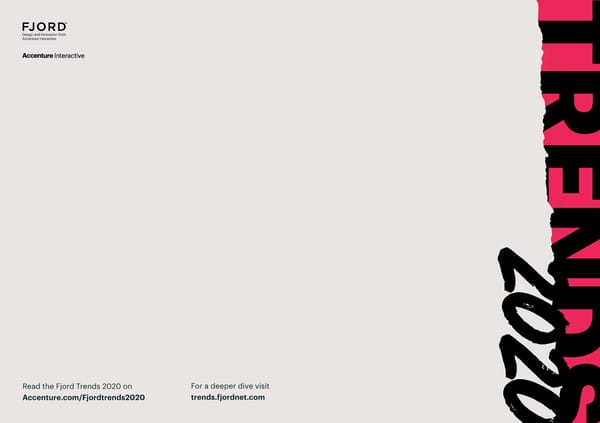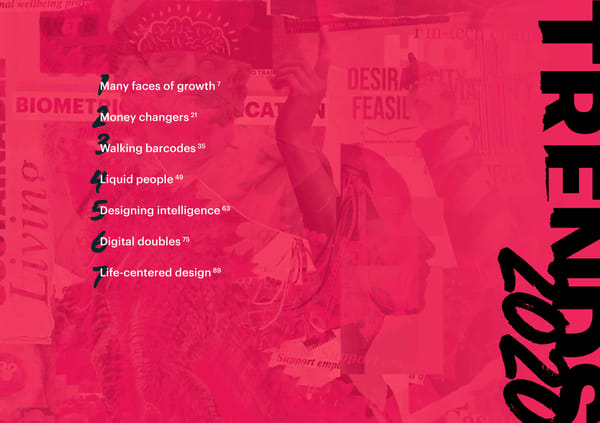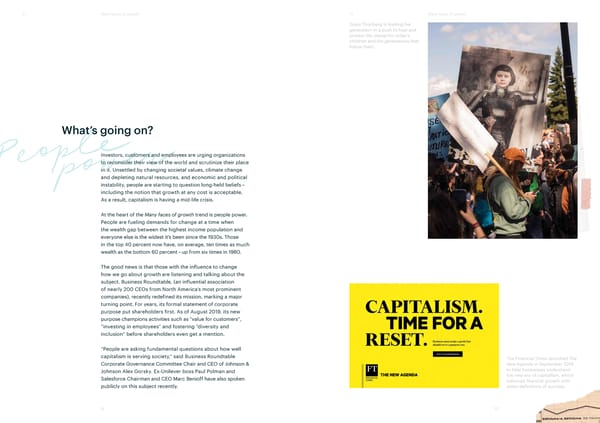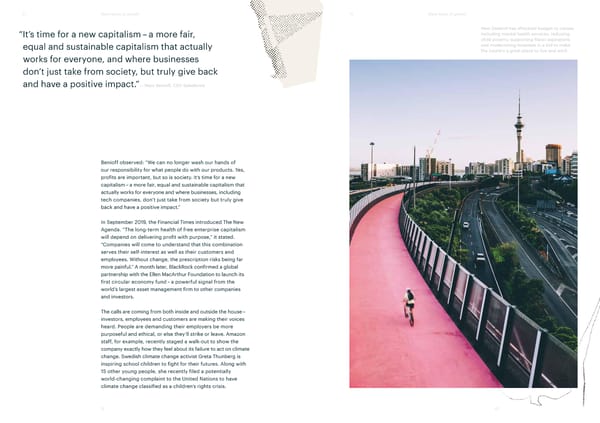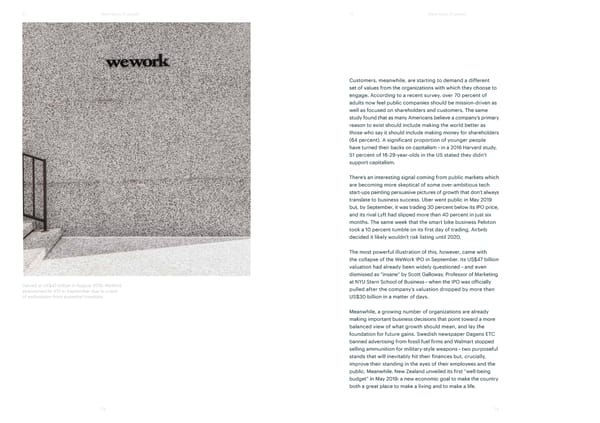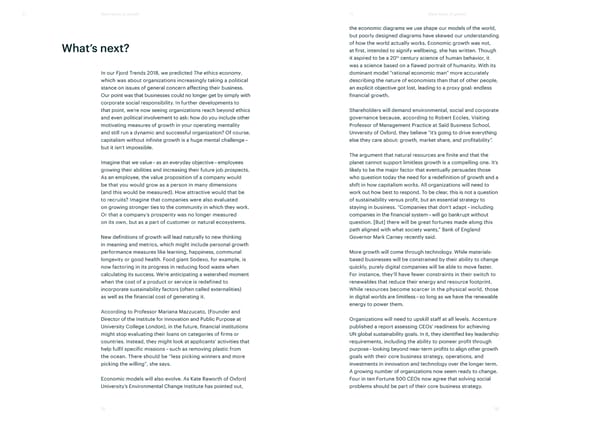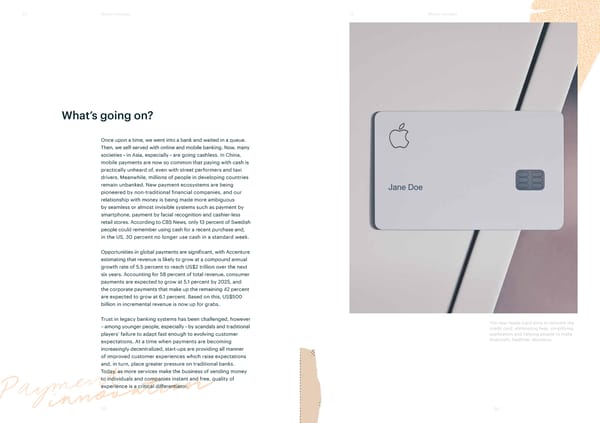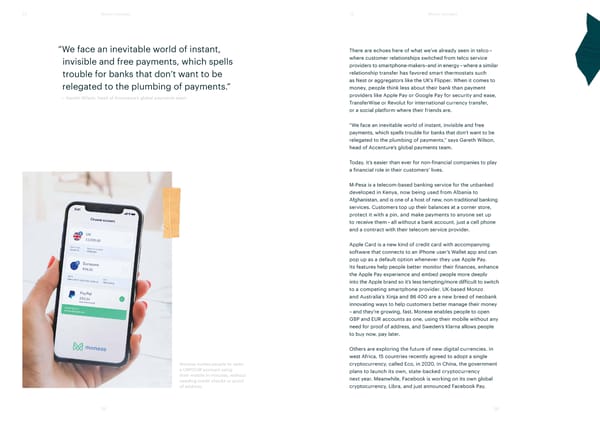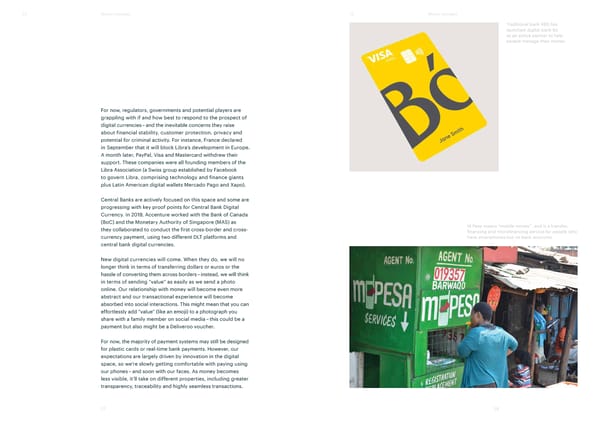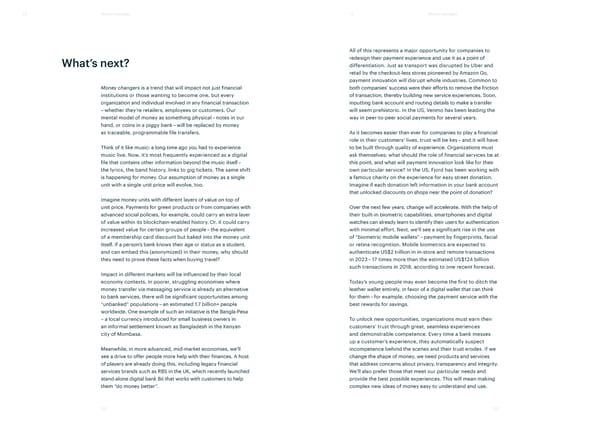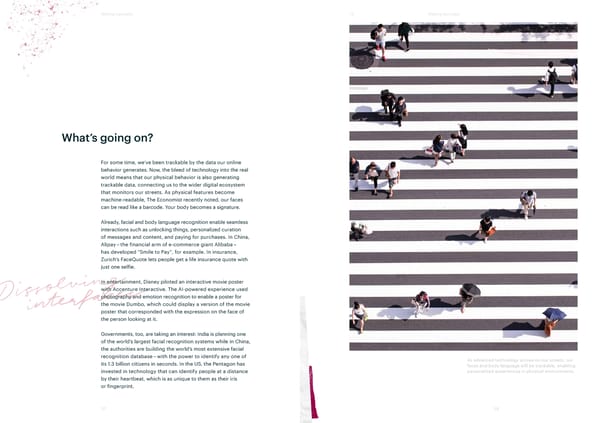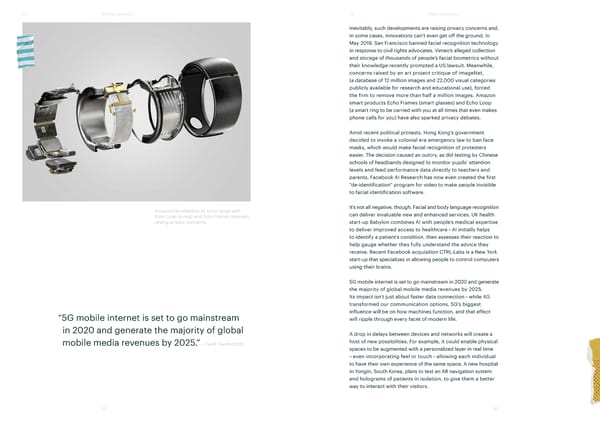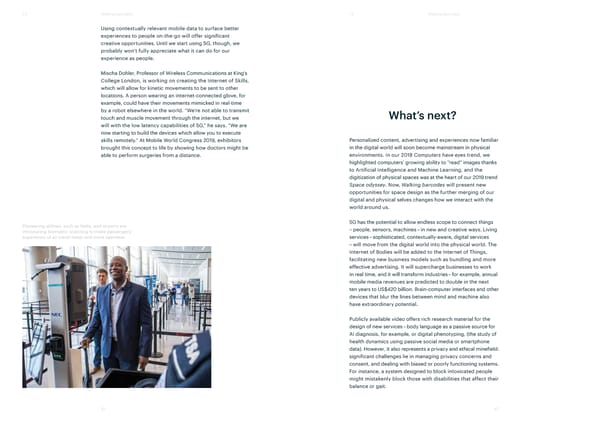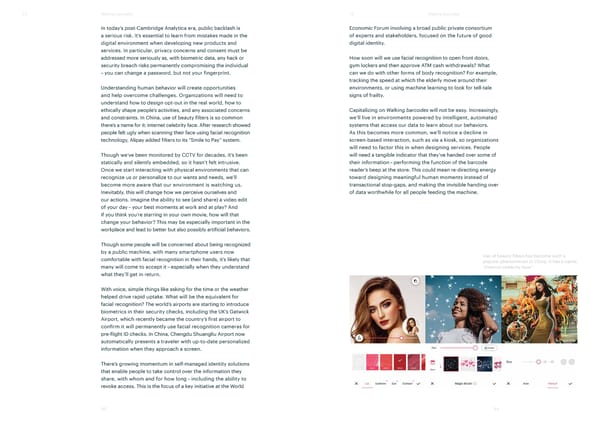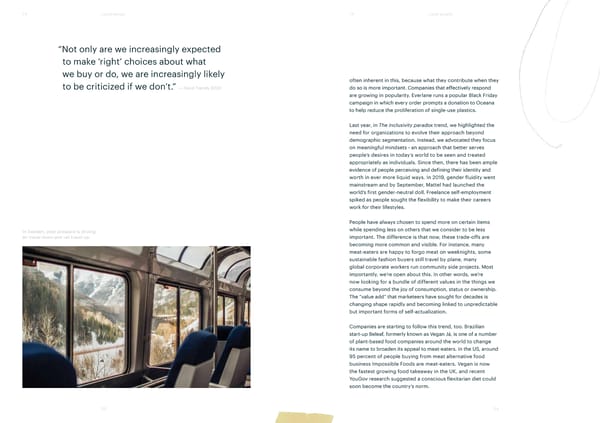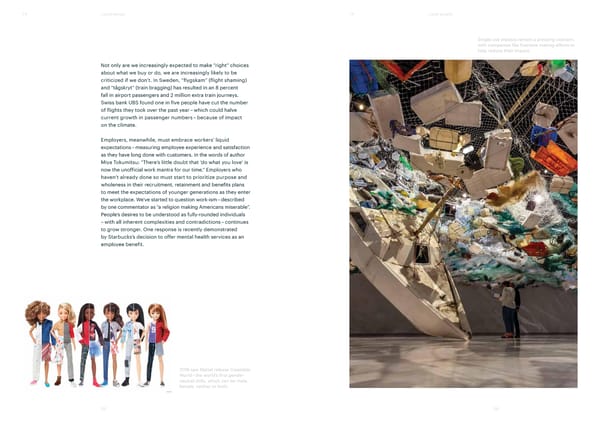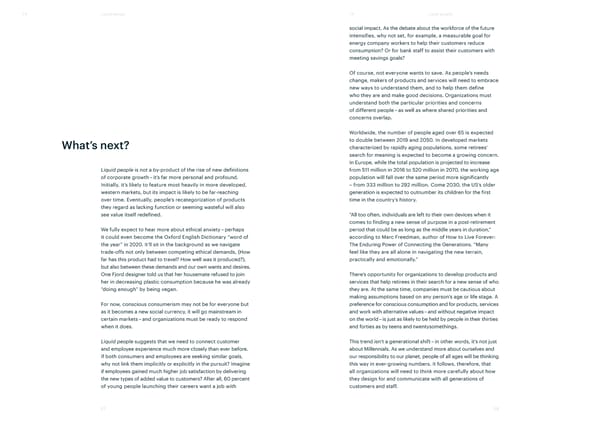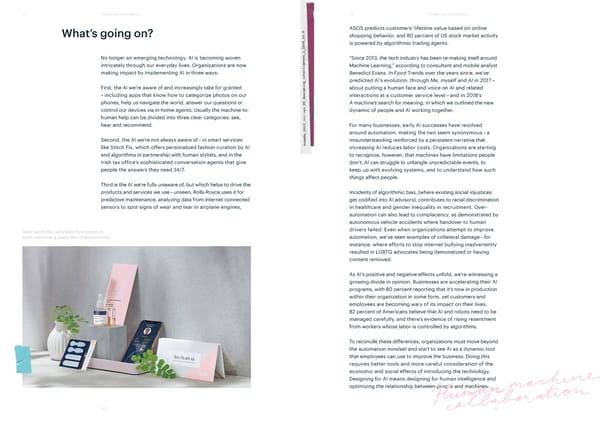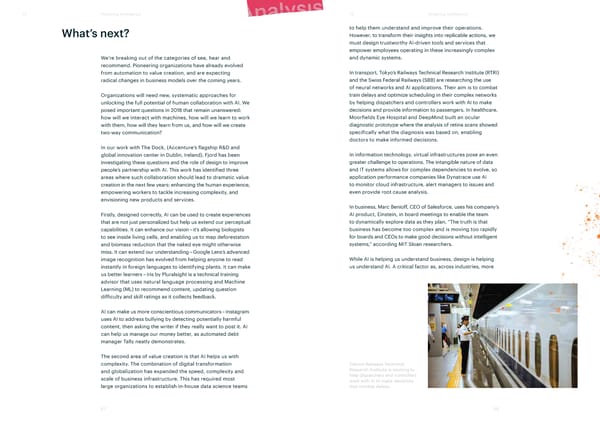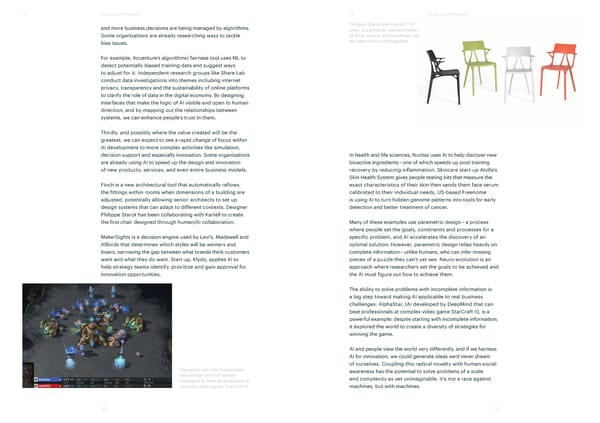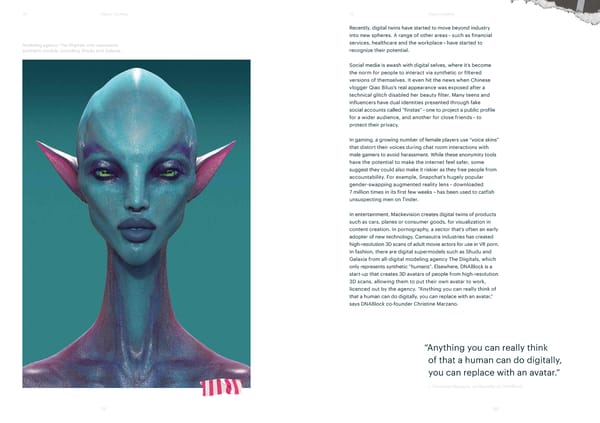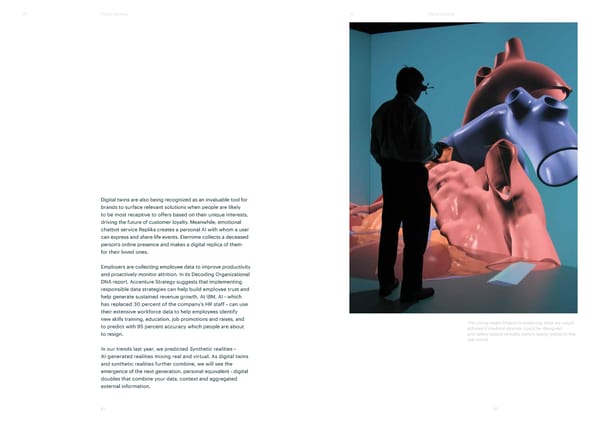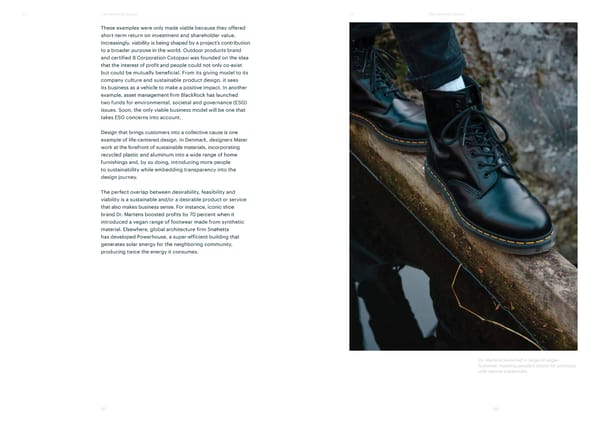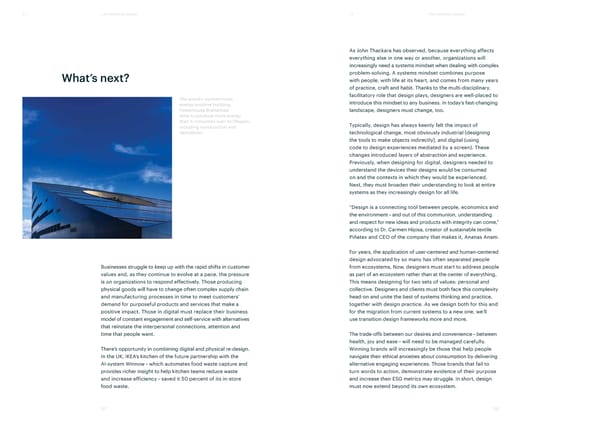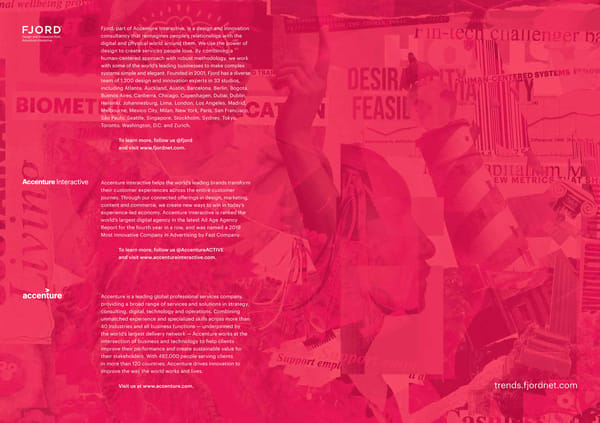xReport
Interactive Report | Fjord is a design and innovation consultancy that reimagines people’s relationships with the digital and physical world | 55 Pages
Read the Fjord Trends 2020 on For a deeper dive visit Accenture.com/Fjordtrends2020 trends.fjordnet.com
Many faces of growth 7 21 Money changers Walking barcodes 35 Liquid people 49 63 Designing intelligence Digital doubles 75 Life-centered design 89
Meta-trend: Realigning the fundamentals Every year, Fjord – Accenture Interactive’s design and innovation Meanwhile, technology continues to create change: now, practice – crowdsources trends for the year ahead from its it’s changing the shape of money, recognizing our bodies as network of 1,200 people in 33 studios worldwide. With new a form of signature, and creating virtual doubles. studios opening in Japan and across Latin America, this year’s Fjord Trends are our most globally diverse. Yet, despite the 2020’s meta-trend is nothing short of a major realignment of diversity of regional flavors and context, there was a high level the fundamentals. It’s tempting to misinterpret this as a gloomy of consensus in our initial idea-gathering stage. These are picture – instead, we think this is a once-in-a-lifetime chance also our most closely connected trends ever, telling a compre- to innovate in business models, services and products around hensive story about our landscape and what’s coming next. new definitions of value. Economics and politics, capitalism and resources, technology For companies with the courage to recognize this meta-trend, and society have long been entwined, but recently the there are many opportunities – and there will also be challenges. consequences of that entanglement have burst into public For example, it questions the decades-old definition we’ve had consciousness – ironically, driven by the very technologies of business success, which is underpinned by the philosophy that made such interconnectivity possible. The omnipresence of profit as the only directive. of digital and the internet have been big (possibly decisive) factors in the prominence of President Trump and Greta This realignment also potentially leads to iconic innovation Thunberg, of Amazon.com and the gig economy, smartphones moving beyond start-ups in favor of more traditional businesses and techlash and, indeed, the re-evaluation of Silicon Valley that will need to work together to make change happen at an start-ups triggered by the failure of WeWork’s IPO. industry-wide level. We might see a two-speed model emerging as the shift takes place at different paces in different markets. Questions about capitalism’s trajectory of endless growth Emerging markets might just leapfrog western attitudes toward with profit as the sole metric have moved from shouting on the endless consumption and go straight for a more balanced streets to conversations in the boardroom. Concerns about view. Meanwhile, people continue to be ever more fluid in their plastic have developed into a major climate crisis movement, behaviors, constantly shifting between traditional demographic which is now among voters’ top priorities in many countries. segments in ways that seem contradictory. The clash between the technology industry and governments is causing widely felt tremors, as tech giants are considered However it plays out from here, one thing is likely: those who to have immense power but there’s disagreement about who embrace the long-term view – by starting with their impact on should be held accountable. the world and society, and embracing the systemic complexity of the world–will emerge as winners. Two years ago, we highlighted Tensions as our meta-trend. In retrospect, that led directly to last year’s meta-trend, The search for value. Now, that search has evolved into a re- evaluation of purpose and place in the world by governments, businesses and individuals alike.
e s ar e been singular in their aim: financial v s ha s and customer estor v s, companie , in w th as . No w or decade o F es of gr aster the better asur and the f – wth o s against other me gr ernance metrics. v aluate activitie – v al, social or go pushing to e onment s not vir ough en ofit-bashing, but it’ ell, perhaps thr w ys that enhance our a w w ss wth in ne o y to assume that this is all about pr s eas It’ s sole busine edefine gr ’ e call to r ganization this is a positiv wth is no longer an or sue them without o e pur s. If financial gr w do w ganizational e ? And ho liv s or or e the other ssential f wth , what ar o e ofit is ultimately e objectiv act that pr edefinition of gr e can ys w a losing sight of the f e that tension, the r w w esolv e can r tunity to imagine ne vity? If w longe s an epoch-changing oppor er . off alue ate v eate and celebr cr
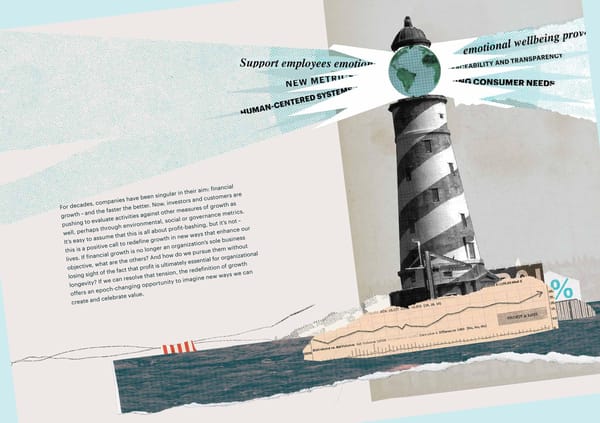

T1 Many faces of growth T1 Many faces of growth Greta Thunberg is leading her generation in a push to heal and protect the planet for today’s children and the generations that follow them. What’s going on? Investors, customers and employees are urging organizations to reconsider their view of the world and scrutinize their place in it. Unsettled by changing societal values, climate change and depleting natural resources, and economic and political instability, people are starting to question long-held beliefs – including the notion that growth at any cost is acceptable. As a result, capitalism is having a mid-life crisis. At the heart of the Many faces of growth trend is people power. People are fueling demands for change at a time when the wealth gap between the highest income population and everyone else is the widest it’s been since the 1930s. Those in the top 40 percent now have, on average, ten times as much wealth as the bottom 60 percent – up from six times in 1980. The good news is that those with the influence to change how we go about growth are listening and talking about the subject. Business Roundtable, (an influential association of nearly 200 CEOs from North America’s most prominent companies), recently redefined its mission, marking a major turning point. For years, its formal statement of corporate purpose put shareholders first. As of August 2019, its new purpose champions activities such as “value for customers”, “investing in employees” and fostering “diversity and inclusion” before shareholders even get a mention. “People are asking fundamental questions about how well capitalism is serving society,” said Business Roundtable The Financial Times launched The Corporate Governance Committee Chair and CEO of Johnson & New Agenda in September 2019 Johnson Alex Gorsky. Ex-Unilever boss Paul Polman and to help businesses understand Salesforce Chairman and CEO Marc Benioff have also spoken the new era of capitalism, which balances financial growth with publicly on this subject recently. wider definitions of success. 9 10
T1 Many faces of growth T1 Many faces of growth New Zealand has allocated budget to causes “It’s time for a new capitalism – a more fair, including mental health services, reducing child poverty, supporting Maori aspirations equal and sustainable capitalism that actually and modernizing hospitals in a bid to make the country a great place to live and work. works for everyone, and where businesses don’t just take from society, but truly give back and have a positive impact.”— Marc Benioff, CEO Salesforce Benioff observed: “We can no longer wash our hands of our responsibility for what people do with our products. Yes, profits are important, but so is society. It’s time for a new capitalism – a more fair, equal and sustainable capitalism that actually works for everyone and where businesses, including tech companies, don’t just take from society but truly give back and have a positive impact.” In September 2019, the Financial Times introduced The New Agenda. “The long-term health of free enterprise capitalism will depend on delivering profit with purpose,” it stated. “Companies will come to understand that this combination serves their self-interest as well as their customers and employees. Without change, the prescription risks being far more painful.” A month later, BlackRock confirmed a global partnership with the Ellen MacArthur Foundation to launch its first circular economy fund – a powerful signal from the world’s largest asset management firm to other companies and investors. The calls are coming from both inside and outside the house – investors, employees and customers are making their voices heard. People are demanding their employers be more purposeful and ethical, or else they’ll strike or leave. Amazon staff, for example, recently staged a walk-out to show the company exactly how they feel about its failure to act on climate change. Swedish climate change activist Greta Thunberg is inspiring school children to fight for their futures. Along with 15 other young people, she recently filed a potentially world-changing complaint to the United Nations to have climate change classified as a children’s rights crisis. 11 12
T1 Many faces of growth T1 Many faces of growth Customers, meanwhile, are starting to demand a different set of values from the organizations with which they choose to engage. According to a recent survey, over 70 percent of adults now feel public companies should be mission-driven as well as focused on shareholders and customers. The same study found that as many Americans believe a company’s primary reason to exist should include making the world better as those who say it should include making money for shareholders (64 percent). A significant proportion of younger people have turned their backs on capitalism – in a 2016 Harvard study, 51 percent of 18-29-year-olds in the US stated they didn’t support capitalism. There’s an interesting signal coming from public markets which are becoming more skeptical of some over-ambitious tech start-ups painting persuasive pictures of growth that don’t always translate to business success. Uber went public in May 2019 but, by September, it was trading 30 percent below its IPO price, and its rival Lyft had slipped more than 40 percent in just six months. The same week that the smart bike business Peloton took a 10 percent tumble on its first day of trading, Airbnb decided it likely wouldn’t risk listing until 2020. The most powerful illustration of this, however, came with the collapse of the WeWork IPO in September. Its US$47 billion valuation had already been widely questioned – and even dismissed as “insane” by Scott Galloway, Professor of Marketing Valued at US$47 billion in August 2019, WeWork at NYU Stern School of Business – when the IPO was officially abandoned its IPO in September due to a lack pulled after the company’s valuation dropped by more than of enthusiasm from potential investors. US$30 billion in a matter of days. Meanwhile, a growing number of organizations are already making important business decisions that point toward a more balanced view of what growth should mean, and lay the foundation for future gains. Swedish newspaper Dagens ETC banned advertising from fossil fuel firms and Walmart stopped selling ammunition for military-style weapons – two purposeful stands that will inevitably hit their finances but, crucially, improve their standing in the eyes of their employees and the public. Meanwhile, New Zealand unveiled its first “well-being budget” in May 2019: a new economic goal to make the country both a great place to make a living and to make a life. 13 14
T1 Many faces of growth T1 Many faces of growth the economic diagrams we use shape our models of the world, but poorly designed diagrams have skewed our understanding What’s next? of how the world actually works. Economic growth was not, at first, intended to signify wellbeing, she has written. Though it aspired to be a 20th century science of human behavior, it was a science based on a flawed portrait of humanity. With its In our Fjord Trends 2018, we predicted The ethics economy, dominant model “rational economic man” more accurately which was about organizations increasingly taking a political describing the nature of economists than that of other people, stance on issues of general concern affecting their business. an explicit objective got lost, leading to a proxy goal: endless Our point was that businesses could no longer get by simply with financial growth. corporate social responsibility. In further developments to that point, we’re now seeing organizations reach beyond ethics Shareholders will demand environmental, social and corporate and even political involvement to ask: how do you include other governance because, according to Robert Eccles, Visiting motivating measures of growth in your operating mentality Professor of Management Practice at Saïd Business School, and still run a dynamic and successful organization? Of course, University of Oxford, they believe “it’s going to drive everything capitalism without infinite growth is a huge mental challenge – else they care about: growth, market share, and profitability”. but it isn’t impossible. The argument that natural resources are finite and that the Imagine that we value – as an everyday objective – employees planet cannot support limitless growth is a compelling one. It’s growing their abilities and increasing their future job prospects. likely to be the major factor that eventually persuades those As an employee, the value proposition of a company would who question today the need for a redefinition of growth and a be that you would grow as a person in many dimensions shift in how capitalism works. All organizations will need to (and this would be measured). How attractive would that be work out how best to respond. To be clear, this is not a question to recruits? Imagine that companies were also evaluated of sustainability versus profit, but an essential strategy to on growing stronger ties to the community in which they work. staying in business. “Companies that don’t adapt – including Or that a company’s prosperity was no longer measured companies in the financial system – will go bankrupt without on its own, but as a part of customer or natural ecosystems. question. [But] there will be great fortunes made along this path aligned with what society wants,” Bank of England New definitions of growth will lead naturally to new thinking Governor Mark Carney recently said. in meaning and metrics, which might include personal growth performance measures like learning, happiness, communal More growth will come through technology. While materials- longevity or good health. Food giant Sodexo, for example, is based businesses will be constrained by their ability to change now factoring in its progress in reducing food waste when quickly, purely digital companies will be able to move faster. calculating its success. We’re anticipating a watershed moment For instance, they’ll have fewer constraints in their switch to when the cost of a product or service is redefined to renewables that reduce their energy and resource footprint. incorporate sustainability factors (often called externalities) While resources become scarcer in the physical world, those as well as the financial cost of generating it. in digital worlds are limitless – so long as we have the renewable energy to power them. According to Professor Mariana Mazzucato, (Founder and Director of the Institute for Innovation and Public Purpose at Organizations will need to upskill staff at all levels. Accenture University College London), in the future, financial institutions published a report assessing CEOs’ readiness for achieving might stop evaluating their loans on categories of firms or UN global sustainability goals. In it, they identified key leadership countries. Instead, they might look at applicants’ activities that requirements, including the ability to pioneer profit through help fulfil specific missions – such as removing plastic from purpose – looking beyond near-term profits to align other growth the ocean. There should be “less picking winners and more goals with their core business strategy, operations, and picking the willing”, she says. investments in innovation and technology over the longer term. A growing number of organizations now seem ready to change. Economic models will also evolve. As Kate Raworth of Oxford Four in ten Fortune 500 CEOs now agree that solving social University’s Environmental Change Institute has pointed out, problems should be part of their core business strategy. 15 16
T1 Many faces of growth T1 Many faces of growth “The long-term health of free enterprise capitalism will depend on delivering profit with purpose. Companies will come to understand that this combination serves their self-interest as well as their customers and employees.” — Financial Times, The New Agenda Our planet and its finite natural resources cannot support limitless growth, prompting a need to rethink how we use our world and how we can reduce our negative impact. 17 18
T1 Many faces of growth T1 Many faces of growth Think How will you define new types of value you can deliver while making the profit required to thrive? And how will Customer Experience and Employee Experience work together to create that value at the points of creation and delivery? Say Ask your employees what sort of growth they’d like to see in the organization. Get s Reimagine how you define the debate going. st and measure growth for Do Start to embed new metrics (alongside financial growth) to drive behaviors. What you different stakeholders. measure counts. Collaborate with those willing to make change happen at an industrial level, as effective change is easier to commit to if many join the game. How are you set up for different value to be rewarded? How do you motivate people? d sugge jor F 19 20
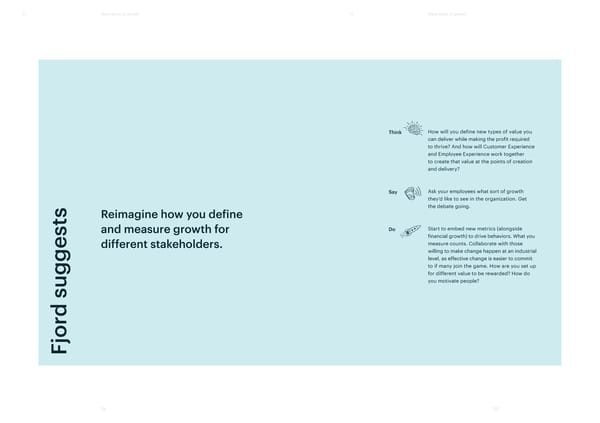
o e think of it at a macr w w s ho y is changing. This include ery notion and shape of xperience of mone ). The v o (what it can do Our e elationship with it, and thus the – ception of it, r ysical entity scale (what it is) and at the micr as a ph e v and so is our per y w a w w – , mone , in a ne y is morphing w mone or things. Once ds. No ying f edit car ed er w e think about pa ystems po w w ho change ecos x alue e om that began a long time ago with cr y fr a visible v w t a ds in e than just buy things and shif ar w olving to v s us to do mor olution, s e v , it’ t that enable s. In this e of change al shif vice opportunitie alue a fundament orms of v – y digital b oduct and ser esent multiple f w pr epr e w) ar old and ne opens up a host of ne ormation with it and r s ( , bank , but in y can carry other inf t the same time w mone encies. A sonal finances not only no t national curr ’ en that ar e think about our per ys w a . ating the w v inno , using Artificial Intelligence e our near futur
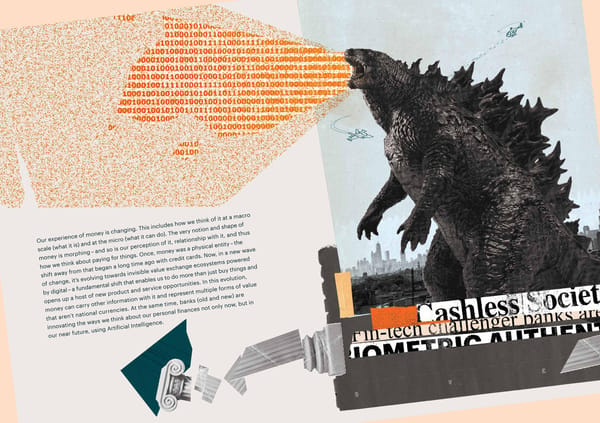

T2 Money changers T2 Money changers What’s going on? Once upon a time, we went into a bank and waited in a queue. Then, we self-served with online and mobile banking. Now, many societies – in Asia, especially – are going cashless. In China, mobile payments are now so common that paying with cash is practically unheard of, even with street performers and taxi drivers. Meanwhile, millions of people in developing countries remain unbanked. New payment ecosystems are being pioneered by non-traditional financial companies, and our relationship with money is being made more ambiguous by seamless or almost invisible systems such as payment by smartphone, payment by facial recognition and cashier-less retail stores. According to CBS News, only 13 percent of Swedish people could remember using cash for a recent purchase and, in the US, 30 percent no longer use cash in a standard week. Opportunities in global payments are significant, with Accenture estimating that revenue is likely to grow at a compound annual growth rate of 5.5 percent to reach US$2 trillion over the next six years. Accounting for 58 percent of total revenue, consumer payments are expected to grow at 5.1 percent by 2025, and the corporate payments that make up the remaining 42 percent are expected to grow at 6.1 percent. Based on this, US$500 billion in incremental revenue is now up for grabs. Trust in legacy banking systems has been challenged, however The new Apple Card aims to reinvent the – among younger people, especially – by scandals and traditional credit card, eliminating fees, simplifying players’ failure to adapt fast enough to evolving customer application and helping people to make expectations. At a time when payments are becoming financially healthier decisions. increasingly decentralized, start-ups are providing all manner of improved customer experiences which raise expectations and, in turn, place greater pressure on traditional banks. Today, as more services make the business of sending money to individuals and companies instant and free, quality of experience is a critical differentiator. 23 24
T2 Money changers T2 Money changers “We face an inevitable world of instant, There are echoes here of what we’ve already seen in telco – invisible and free payments, which spells where customer relationships switched from telco service providers to smartphone-makers–and in energy – where a similar trouble for banks that don’t want to be relationship transfer has favored smart thermostats such as Nest or aggregators like the UK’s Flipper. When it comes to relegated to the plumbing of payments.” money, people think less about their bank than payment — Gareth Wilson, head of Accenture’s global payments team providers like Apple Pay or Google Pay for security and ease, TransferWise or Revolut for international currency transfer, or a social platform where their friends are. “We face an inevitable world of instant, invisible and free payments, which spells trouble for banks that don’t want to be relegated to the plumbing of payments,” says Gareth Wilson, head of Accenture’s global payments team. Today, it’s easier than ever for non-financial companies to play a financial role in their customers’ lives. M-Pesa is a telecom-based banking service for the unbanked developed in Kenya, now being used from Albania to Afghanistan, and is one of a host of new, non-traditional banking services. Customers top up their balances at a corner store, protect it with a pin, and make payments to anyone set up to receive them – all without a bank account, just a cell phone and a contract with their telecom service provider. Apple Card is a new kind of credit card with accompanying software that connects to an iPhone user’s Wallet app and can pop up as a default option whenever they use Apple Pay. Its features help people better monitor their finances, enhance the Apple Pay experience and embed people more deeply into the Apple brand so it’s less tempting/more difficult to switch to a competing smartphone provider. UK-based Monzo and Australia’s Xinja and 86400 are a new breed of neobank innovating ways to help customers better manage their money – and they’re growing, fast. Monese enables people to open GBP and EUR accounts as one, using their mobile without any need for proof of address, and Sweden’s Klarna allows people to buy now, pay later. Others are exploring the future of new digital currencies. In west Africa, 15 countries recently agreed to adopt a single Monese invites people to open cryptocurrency, called Eco, in 2020. In China, the government a GBP/EUR account using plans to launch its own, state-backed cryptocurrency their mobile in minutes, without next year. Meanwhile, Facebook is working on its own global needing credit checks or proof of address. cryptocurrency, Libra, and just announced Facebook Pay. 25 26
T2 Money changers T2 Money changers Traditional bank RBS has launched digital bank Bó as an active partner to help people manage their money. For now, regulators, governments and potential players are grappling with if and how best to respond to the prospect of digital currencies – and the inevitable concerns they raise about financial stability, customer protection, privacy and potential for criminal activity. For instance, France declared in September that it will block Libra’s development in Europe. A month later, PayPal, Visa and Mastercard withdrew their support. These companies were all founding members of the Libra Association (a Swiss group established by Facebook to govern Libra, comprising technology and finance giants plus Latin American digital wallets Mercado Pago and Xapo). Central Banks are actively focused on this space and some are progressing with key proof points for Central Bank Digital Currency. In 2019, Accenture worked with the Bank of Canada (BoC) and the Monetary Authority of Singapore (MAS) as M-Pesa means “mobile money”, and is a transfer, they collaborated to conduct the first cross-border and cross- financing and microfinancing service for people who currency payment, using two different DLT platforms and have smartphones but no bank accounts. central bank digital currencies. New digital currencies will come. When they do, we will no longer think in terms of transferring dollars or euros or the hassle of converting them across borders – instead, we will think in terms of sending “value” as easily as we send a photo online. Our relationship with money will become even more abstract and our transactional experience will become absorbed into social interactions. This might mean that you can effortlessly add “value” (like an emoji) to a photograph you share with a family member on social media – this could be a payment but also might be a Deliveroo voucher. For now, the majority of payment systems may still be designed for plastic cards or real-time bank payments. However, our expectations are largely driven by innovation in the digital space, so we’re slowly getting comfortable with paying using our phones – and soon with our faces. As money becomes less visible, it’ll take on different properties, including greater transparency, traceability and highly seamless transactions. 27 28
T2 Money changers T2 Money changers All of this represents a major opportunity for companies to What’s next? redesign their payment experience and use it as a point of differentiation. Just as transport was disrupted by Uber and retail by the checkout-less stores pioneered by Amazon Go, payment innovation will disrupt whole industries. Common to Money changers is a trend that will impact not just financial both companies’ success were their efforts to remove the friction institutions or those wanting to become one, but every of transaction, thereby building new service experiences. Soon, organization and individual involved in any financial transaction inputting bank account and routing details to make a transfer – whether they’re retailers, employees or customers. Our will seem prehistoric. In the US, Venmo has been leading the mental model of money as something physical – notes in our way in peer-to-peer social payments for several years. hand, or coins in a piggy bank – will be replaced by money as traceable, programmable file transfers. As it becomes easier than ever for companies to play a financial role in their customers’ lives, trust will be key – and it will have Think of it like music: a long time ago you had to experience to be built through quality of experience. Organizations must music live. Now, it’s most frequently experienced as a digital ask themselves: what should the role of financial services be at file that contains other information beyond the music itself – this point, and what will payment innovation look like for their the lyrics, the band history, links to gig tickets. The same shift own particular service? In the US, Fjord has been working with is happening for money. Our assumption of money as a single a famous charity on the experience for easy street donation. unit with a single unit price will evolve, too. Imagine if each donation left information in your bank account that unlocked discounts on shops near the point of donation? Imagine money units with different layers of value on top of unit price. Payments for green products or from companies with Over the next few years, change will accelerate. With the help of advanced social policies, for example, could carry an extra layer their built-in biometric capabilities, smartphones and digital of value within its blockchain-enabled history. Or, it could carry watches can already learn to identify their users for authentication increased value for certain groups of people – the equivalent with minimal effort. Next, we’ll see a significant rise in the use of a membership card discount but baked into the money unit of “biometric mobile wallets” – payment by fingerprints, facial itself. If a person’s bank knows their age or status as a student, or retina recognition. Mobile biometrics are expected to and can embed this (anonymized) in their money, why should authenticate US$2 trillion in in-store and remote transactions they need to prove these facts when buying travel? in 2023 – 17 times more than the estimated US$124 billion such transactions in 2018, according to one recent forecast. Impact in different markets will be influenced by their local economy contexts. In poorer, struggling economies where Today’s young people may even become the first to ditch the money transfer via messaging service is already an alternative leather wallet entirely, in favor of a digital wallet that can think to bank services, there will be significant opportunities among for them – for example, choosing the payment service with the “unbanked” populations – an estimated 1.7 billion+ people best rewards for savings. worldwide. One example of such an initiative is the Bangla-Pesa – a local currency introduced for small business owners in To unlock new opportunities, organizations must earn their an informal settlement known as Bangladesh in the Kenyan customers’ trust through great, seamless experiences city of Mombasa. and demonstrable competence. Every time a bank messes up a customer’s experience, they automatically suspect Meanwhile, in more advanced, mid-market economies, we’ll incompetence behind the scenes and their trust erodes. If we see a drive to offer people more help with their finances. A host change the shape of money, we need products and services of players are already doing this, including legacy financial that address concerns about privacy, transparency and integrity. services brands such as RBS in the UK, which recently launched We’ll also prefer those that meet our particular needs and stand-alone digital bank Bó that works with customers to help provide the best possible experiences. This will mean making them “do money better”. complex new ideas of money easy to understand and use. 29 30
T2 Money changers T2 Money changers “Today, as more services make the business of sending money to individuals and companies instant and free, quality of experience is a critical differentiator.”— Fjord Trends 2020 ATMs might soon become relics from a bygone era, with many societies starting to go cashless. 31 32
T2 Money changers T2 Money changers Think If your service were a part of money transactions, what would it look like? For example, if every payment carried information about you or your customers, what would that be? How useful could you make it? How will the changing landscape of money affect your business and customers? Say Communicate why people can trust your organization. Highlight your customers’ s Reimagine transaction trust as an asset you can extend to new st and payment as a source financial offerings. of innovation and Do Move to where people are going to manage money, and build on services they already competitive advantage. use (i.e. technology like SMS or services like neobanks). Follow these closely and look for new product opportunities around people’s money goals. d sugge jor F 33 34
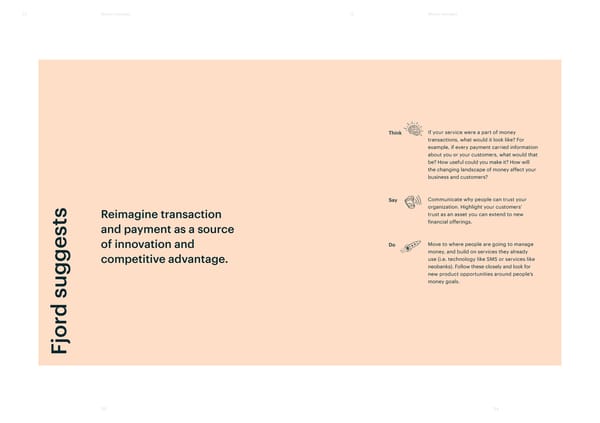
or technology to ys f a w w s e finding ne actor r ’ se f e . Combined, the . e dissolving, and w vior e y lif s ar da ery ace v f s of our beha Inter e ying our e eatur y both us and f ootprints identif tunities to continue simplif al f ving digit a of lea acial , f eate amazing oppor w cr ortable with the ide e it much). No e r ’ wn comf e o e might not lik e gr v ’ ad, so w e e W e go online (though w spr ith e w e becoming wide orld. W erywher eal w v e ecognition ar e go in the r e w w erywher sign ne v and body language r ail e a ysical cookie tr s abundant potential to de orld dat ’ ving a ph e ysical w lea , ther s of ph ound the corner ess the challenge 5G right ar orld solutions and s that addr w vice eal- with r – oducts and ser ation pr sonaliz collection and content per xperiences. enhanced e
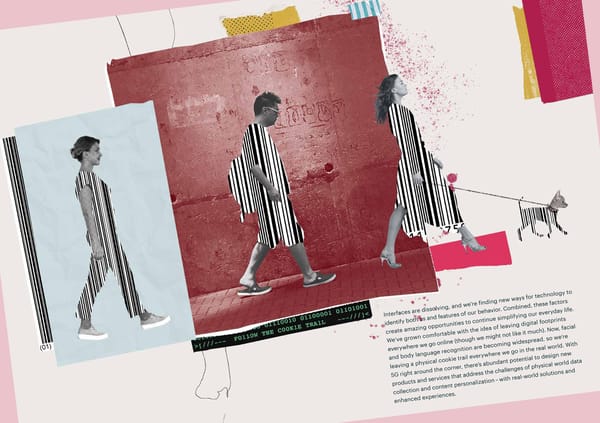

T3 Walking barcodes T3 Walking barcodes What’s going on? For some time, we’ve been trackable by the data our online behavior generates. Now, the bleed of technology into the real world means that our physical behavior is also generating trackable data, connecting us to the wider digital ecosystem that monitors our streets. As physical features become machine-readable, The Economist recently noted, our faces can be read like a barcode. Your body becomes a signature. Already, facial and body language recognition enable seamless interactions such as unlocking things, personalized curation of messages and content, and paying for purchases. In China, Alipay – the financial arm of e-commerce giant Alibaba – has developed “Smile to Pay”, for example. In insurance, Zurich’s FaceQuote lets people get a life insurance quote with just one selfie. In entertainment, Disney piloted an interactive movie poster with Accenture Interactive. The AI-powered experience used photography and emotion recognition to enable a poster for the movie Dumbo, which could display a version of the movie poster that corresponded with the expression on the face of the person looking at it. Governments, too, are taking an interest: India is planning one of the world’s largest facial recognition systems while in China, the authorities are building the world’s most extensive facial recognition database – with the power to identify any one of As advanced technology arrives on our streets, our its 1.3 billion citizens in seconds. In the US, the Pentagon has faces and body language will be trackable, enabling invested in technology that can identify people at a distance personalized experiences in physical environments. by their heartbeat, which is as unique to them as their iris or fingerprint. 37 38
T3 Walking barcodes T3 Walking barcodes Inevitably, such developments are raising privacy concerns and, in some cases, innovations can’t even get off the ground. In May 2019, San Francisco banned facial recognition technology in response to civil rights advocates. Vimeo’s alleged collection and storage of thousands of people’s facial biometrics without their knowledge recently prompted a US lawsuit. Meanwhile, concerns raised by an art project critique of ImageNet, (a database of 12 million images and 22,000 visual categories publicly available for research and educational use), forced the firm to remove more than half a million images. Amazon smart products Echo Frames (smart glasses) and Echo Loop (a smart ring to be carried with you at all times that even makes phone calls for you) have also sparked privacy debates. Amid recent political protests, Hong Kong’s government decided to invoke a colonial era emergency law to ban face masks, which would make facial recognition of protesters easier. The decision caused an outcry, as did testing by Chinese schools of headbands designed to monitor pupils’ attention levels and feed performance data directly to teachers and parents. Facebook AI Research has now even created the first “de-identification” program for video to make people invisible to facial identification software. Amazon has added to its Echo range with It’s not all negative, though. Facial and body language recognition Echo Loop (a ring) and Echo Frames (glasses), can deliver invaluable new and enhanced services. UK health raising privacy concerns. start-up Babylon combines AI with people’s medical expertise to deliver improved access to healthcare – AI initially helps to identify a patient’s condition, then assesses their reaction to help gauge whether they fully understand the advice they receive. Recent Facebook acquisition CTRL-Labs is a New York start-up that specializes in allowing people to control computers using their brains. 5G mobile internet is set to go mainstream in 2020 and generate the majority of global mobile media revenues by 2025. Its impact isn’t just about faster data connection – while 4G transformed our communication options, 5G’s biggest influence will be on how machines function, and that effect “5G mobile internet is set to go mainstream will ripple through every facet of modern life. in 2020 and generate the majority of global A drop in delays between devices and networks will create a — Fjord Trends 2020 host of new possibilities. For example, it could enable physical mobile media revenues by 2025.” spaces to be augmented with a personalized layer in real time – even incorporating feel or touch – allowing each individual to have their own experience of the same space. A new hospital in Yongin, South Korea, plans to test an AR navigation system and holograms of patients in isolation, to give them a better way to interact with their visitors. 39 40
T3 Walking barcodes T3 Walking barcodes Using contextually relevant mobile data to surface better experiences to people on-the-go will offer significant creative opportunities. Until we start using 5G, though, we probably won’t fully appreciate what it can do for our experience as people. Mischa Dohler, Professor of Wireless Communications at King’s College London, is working on creating the Internet of Skills, which will allow for kinetic movements to be sent to other locations. A person wearing an internet-connected glove, for example, could have their movements mimicked in real-time by a robot elsewhere in the world. “We’re not able to transmit What’s next? touch and muscle movement through the internet, but we will with the low latency capabilities of 5G,” he says. “We are now starting to build the devices which allow you to execute skills remotely.” At Mobile World Congress 2019, exhibitors Personalized content, advertising and experiences now familiar brought this concept to life by showing how doctors might be in the digital world will soon become mainstream in physical able to perform surgeries from a distance. environments. In our 2018 Computers have eyes trend, we highlighted computers’ growing ability to “read” images thanks to Artificial Intelligence and Machine Learning, and the digitization of physical spaces was at the heart of our 2019 trend Space odyssey. Now, Walking barcodes will present new opportunities for space design as the further merging of our digital and physical selves changes how we interact with the world around us. Pioneering airlines, such as Delta, and airports are 5G has the potential to allow endless scope to connect things introducing biometric scanning to make passengers’ – people, sensors, machines – in new and creative ways. Living experience of air travel faster and more seamless. services – sophisticated, contextually-aware, digital services – will move from the digital world into the physical world. The Internet of Bodies will be added to the Internet of Things, facilitating new business models such as bundling and more effective advertising. It will supercharge businesses to work in real time, and it will transform industries – for example, annual mobile media revenues are predicted to double in the next ten years to US$420 billion. Brain-computer interfaces and other devices that blur the lines between mind and machine also have extraordinary potential. Publicly available video offers rich research material for the design of new services – body language as a passive source for AI diagnosis, for example, or digital phenotyping, (the study of health dynamics using passive social media or smartphone data). However, it also represents a privacy and ethical minefield: significant challenges lie in managing privacy concerns and consent, and dealing with biased or poorly functioning systems. For instance, a system designed to block intoxicated people might mistakenly block those with disabilities that affect their balance or gait. 41 42
T3 Walking barcodes T3 Walking barcodes In today’s post-Cambridge Analytica era, public backlash is Economic Forum involving a broad public private consortium a serious risk. It’s essential to learn from mistakes made in the of experts and stakeholders, focused on the future of good digital environment when developing new products and digital identity. services. In particular, privacy concerns and consent must be addressed more seriously as, with biometric data, any hack or How soon will we use facial recognition to open front doors, security breach risks permanently compromising the individual gym lockers and then approve ATM cash withdrawals? What – you can change a password, but not your fingerprint. can we do with other forms of body recognition? For example, tracking the speed at which the elderly move around their Understanding human behavior will create opportunities environments, or using machine learning to look for tell-tale and help overcome challenges. Organizations will need to signs of frailty. understand how to design opt-out in the real world, how to ethically shape people’s activities, and any associated concerns Capitalizing on Walking barcodes will not be easy. Increasingly, and constraints. In China, use of beauty filters is so common we’ll live in environments powered by intelligent, automated there’s a name for it: internet celebrity face. After research showed systems that access our data to learn about our behaviors. people felt ugly when scanning their face using facial recognition As this becomes more common, we’ll notice a decline in technology, Alipay added filters to its “Smile to Pay” system. screen-based interaction, such as via a kiosk, so organizations will need to factor this in when designing services. People Though we’ve been monitored by CCTV for decades, it’s been will need a tangible indicator that they’ve handed over some of statically and silently embedded, so it hasn’t felt intrusive. their information – performing the function of the barcode Once we start interacting with physical environments that can reader’s beep at the store. This could mean re-directing energy recognize us or personalize to our wants and needs, we’ll toward designing meaningful human moments instead of become more aware that our environment is watching us. transactional stop-gaps, and making the invisible handing over Inevitably, this will change how we perceive ourselves and of data worthwhile for all people feeding the machine. our actions. Imagine the ability to see (and share) a video edit of your day – your best moments at work and at play? And if you think you’re starring in your own movie, how will that change your behavior? This may be especially important in the workplace and lead to better but also possibly artificial behaviors. Though some people will be concerned about being recognized by a public machine, with many smartphone users now Use of beauty filters has become such a comfortable with facial recognition in their hands, it’s likely that popular phenomenon in China, it has a name: many will come to accept it – especially when they understand “internet celebrity face”. what they’ll get in return. With voice, simple things like asking for the time or the weather helped drive rapid uptake. What will be the equivalent for facial recognition? The world’s airports are starting to introduce biometrics in their security checks, including the UK’s Gatwick Airport, which recently became the country’s first airport to confirm it will permanently use facial recognition cameras for pre-flight ID checks. In China, Chengdu Shuangliu Airport now automatically presents a traveler with up-to-date personalized information when they approach a screen. There’s growing momentum in self-managed identity solutions that enable people to take control over the information they share, with whom and for how long – including the ability to revoke access. This is the focus of a key initiative at the World 43 44
T3 Walking barcodes T3 Walking barcodes “Now, with facial and body language recognition becoming widespread, we’re leaving a physical cookie trail everywhere we go in the real world.” — Fjord Trends 2020 As we become used to being scanned like barcodes, how will privacy and trust issues evolve? 45 46
T3 Walking barcodes T3 Walking barcodes Think Which of your services could be unlocked by biometrics, (in line with regulations and laws in your sector, of course)? What could you do with facial recognition or understanding body language to reduce friction for people? Look at the human experience of these services: Who do they most convenience? How do people consent? How could improved communications between machines – via s 5G – create new service opportunities? Reimagine new services Say Advocate for data minimalism and educate st for dissolving interfaces, your customers about data consent and privacy – the consequences of data breach enabled by 5G. in biometrics are much more severe. Do Make the invisible visible so people understand when a scan, transaction or consent has taken place. Ensure that people can be the curators of their own personalized experiences – build a platform for people to express, discover, and receive what they want – subject to privacy d sugge laws like GDPR. jor F 47 48
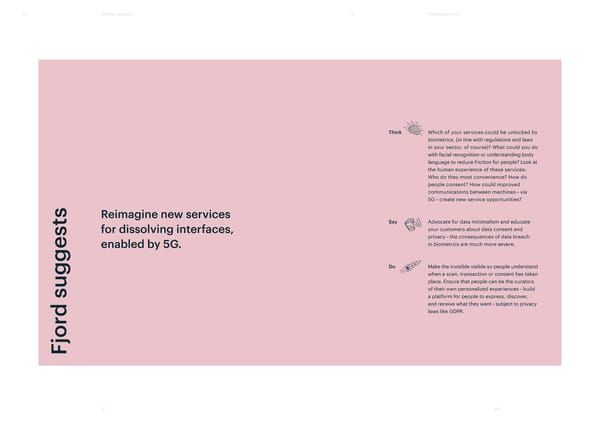
e ving a mid-lif t that capitalism is ha ce businesses e asser or , w e f wth essur o f gr aces o y f s and people-pr Man alue Liquid people In al v wth. o w definition of gr crisis, as changing societ o eassessment of s r ocus on a narr ’ ound ethink their f s about people orld ar to r ad and their impact on the w is the flipside of the same coin: it’ y le es the ans to be a consumer es, the liv ond the stion what it me y themselv s be e all starting to que ? What’ r ’ e ond consumerism them. W y s be . What’ ee e a living? y ans to mak and an emplo ork simply as a me notion of w
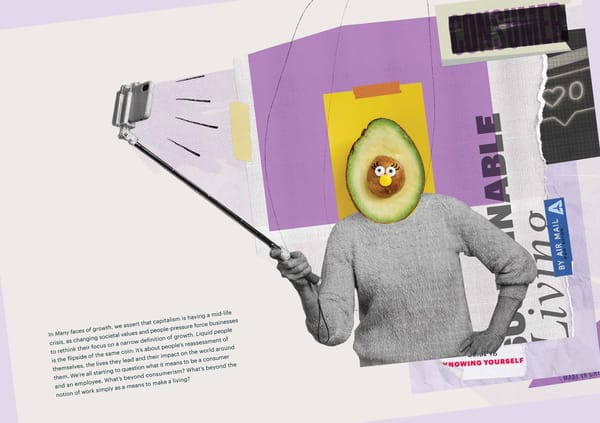

T4 Liquid people T4 Liquid people What’s going on? Something contradictory is happening: we still want to buy, but we’re starting to move away from using material objects to define ourselves. We’re seeking ways to show who we are without pointing to our possessions and what we do for a living – we’re starting to want to be more than that now. We emphasize “starting to” because, of course, we’re still eating hamburgers, buying clothes that make us feel good, flying to interesting places, gazing at shiny new products and wondering if we can afford them (and often buying them regardless). The same is true at work: we’re still working hard for companies we may or may not really like, trying to understand our self-worth through what we do many hours a day. Yet we see signals that this is changing, and consequently, organizations will increasingly need to redefine their understanding of the people they serve and employ, to allow people to find a greater sense of relevance. Consumption is not dead, but it’s changing. For years, we were what we owned, what we drove, what we wore, what we ate. At work and in social settings, we were where we worked and what we did. Those ideas are now challenged – along with other symbols we once used to define our place in the world like nationality, religion, community – because what we buy and why we work have become more fluid. This shift is being driven by a range of factors, including concerns about climate change and a sharper focus on personal wellbeing. Already, a growing number of people are becoming conscious Rising numbers of meat-eaters are choosing consumers. They still consume, but they now do so to support meat-free options from vendors like Impossible a cause and/or do minimal harm to the planet or society. They Foods for ethical and environmental reasons. readily accept the trade-offs between the things they choose to buy or do – no longer sweating about the contradictions 51 52
T4 Liquid people T4 Liquid people “Not only are we increasingly expected to make ‘right’ choices about what we buy or do, we are increasingly likely often inherent in this, because what they contribute when they — Fjord Trends 2020 do so is more important. Companies that effectively respond to be criticized if we don’t.” are growing in popularity. Everlane runs a popular Black Friday campaign in which every order prompts a donation to Oceana to help reduce the proliferation of single-use plastics. Last year, in The inclusivity paradox trend, we highlighted the need for organizations to evolve their approach beyond demographic segmentation. Instead, we advocated they focus on meaningful mindsets – an approach that better serves people’s desires in today’s world to be seen and treated appropriately as individuals. Since then, there has been ample evidence of people perceiving and defining their identity and worth in ever more liquid ways. In 2019, gender fluidity went mainstream and by September, Mattel had launched the world’s first gender-neutral doll. Freelance self-employment spiked as people sought the flexibility to make their careers work for their lifestyles. People have always chosen to spend more on certain items In Sweden, peer pressure is driving while spending less on others that we consider to be less air travel down and rail travel up. important. The difference is that now, these trade-offs are becoming more common and visible. For instance, many meat-eaters are happy to forgo meat on weeknights, some sustainable fashion buyers still travel by plane, many global corporate workers run community side projects. Most importantly, we’re open about this. In other words, we’re now looking for a bundle of different values in the things we consume beyond the joy of consumption, status or ownership. The “value add” that marketeers have sought for decades is changing shape rapidly and becoming linked to unpredictable but important forms of self-actualization. Companies are starting to follow this trend, too. Brazilian start-up Beleaf, formerly known as Vegan Já, is one of a number of plant-based food companies around the world to change its name to broaden its appeal to meat-eaters. In the US, around 95 percent of people buying from meat alternative food business Impossible Foods are meat-eaters. Vegan is now the fastest growing food takeaway in the UK, and recent YouGov research suggested a conscious flexitarian diet could soon become the country’s norm. 53 54
T4 Liquid people T4 Liquid people Single-use plastics remain a pressing concern, with companies like Everlane making efforts to help reduce their impact. Not only are we increasingly expected to make “right” choices about what we buy or do, we are increasingly likely to be criticized if we don’t. In Sweden, “flygskam” (flight shaming) and “tågskryt” (train bragging) has resulted in an 8 percent fall in airport passengers and 2 million extra train journeys. Swiss bank UBS found one in five people have cut the number of flights they took over the past year – which could halve current growth in passenger numbers – because of impact on the climate. Employers, meanwhile, must embrace workers’ liquid expectations – measuring employee experience and satisfaction as they have long done with customers. In the words of author Miya Tokumitsu: “There’s little doubt that ‘do what you love’ is now the unofficial work mantra for our time.” Employers who haven’t already done so must start to prioritize purpose and wholeness in their recruitment, retainment and benefits plans to meet the expectations of younger generations as they enter the workplace. We‘ve started to question work-ism – described by one commentator as “a religion making Americans miserable”. People’s desires to be understood as fully-rounded individuals – with all inherent complexities and contradictions – continues to grow stronger. One response is recently demonstrated by Starbucks’s decision to offer mental health services as an employee benefit. 2019 saw Mattel release Creatable World – the world’s first gender- neutral dolls, which can be male, female, neither or both. 55 56
T4 Liquid people T4 Liquid people social impact. As the debate about the workforce of the future intensifies, why not set, for example, a measurable goal for energy company workers to help their customers reduce consumption? Or for bank staff to assist their customers with meeting savings goals? Of course, not everyone wants to save. As people’s needs change, makers of products and services will need to embrace new ways to understand them, and to help them define who they are and make good decisions. Organizations must understand both the particular priorities and concerns of different people – as well as where shared priorities and concerns overlap. Worldwide, the number of people aged over 65 is expected What’s next? to double between 2019 and 2050. In developed markets characterized by rapidly aging populations, some retirees’ search for meaning is expected to become a growing concern. In Europe, while the total population is projected to increase Liquid people is not a by-product of the rise of new definitions from 511 million in 2016 to 520 million in 2070, the working age of corporate growth – it’s far more personal and profound. population will fall over the same period more significantly Initially, it’s likely to feature most heavily in more developed, – from 333 million to 292 million. Come 2030, the US’s older western markets, but its impact is likely to be far-reaching generation is expected to outnumber its children for the first over time. Eventually, people’s recategorization of products time in the country’s history. they regard as lacking function or seeming wasteful will also see value itself redefined. “All too often, individuals are left to their own devices when it comes to finding a new sense of purpose in a post-retirement We fully expect to hear more about ethical anxiety – perhaps period that could be as long as the middle years in duration,” it could even become the Oxford English Dictionary “word of according to Marc Freedman, author of How to Live Forever: the year” in 2020. It’ll sit in the background as we navigate The Enduring Power of Connecting the Generations. “Many trade-offs not only between competing ethical demands, (How feel like they are all alone in navigating the new terrain, far has this product had to travel? How well was it produced?), practically and emotionally.” but also between these demands and our own wants and desires. One Fjord designer told us that her housemate refused to join There’s opportunity for organizations to develop products and her in decreasing plastic consumption because he was already services that help retirees in their search for a new sense of who “doing enough” by being vegan. they are. At the same time, companies must be cautious about making assumptions based on any person’s age or life stage. A For now, conscious consumerism may not be for everyone but preference for conscious consumption and for products, services as it becomes a new social currency, it will go mainstream in and work with alternative values – and without negative impact certain markets – and organizations must be ready to respond on the world – is just as likely to be held by people in their thirties when it does. and forties as by teens and twentysomethings. Liquid people suggests that we need to connect customer This trend isn’t a generational shift – in other words, it’s not just and employee experience much more closely than ever before. about Millennials. As we understand more about ourselves and If both consumers and employees are seeking similar goals, our responsibility to our planet, people of all ages will be thinking why not link them implicitly or explicitly in the pursuit? Imagine this way in ever-growing numbers. It follows, therefore, that if employees gained much higher job satisfaction by delivering all organizations will need to think more carefully about how the new types of added value to customers? After all, 60 percent they design for and communicate with all generations of of young people launching their careers want a job with customers and staff. 57 58
T4 Liquid people T4 Liquid people “There’s little doubt that ‘do what you love’ is now the unofficial work mantra for our time.”— Miya Tokumitsu, author People are living longer, healthier lives, so our over-65 population is growing–and seeking new purpose when they retire. 59 60
T4 Liquid people T4 Liquid people Think How does your brand enable people to define themselves beyond what they consume, the work they do or the income they earn? How does your business think about people beyond the boxes of “customer” or “employee”? Say Strike the word “consumer” from your vocabulary. Provide people with choices that s allow them to flex and explore their identity. Reimagine your offering Do Set up Human Insights teams instead of st for the era of conscious Consumer Insights – focus less on the number of people that are taking specific actions, consumerism. and more on the context that surrounds their decision-making. Help people navigate anxiety around ethical choices. d sugge jor F 61 62
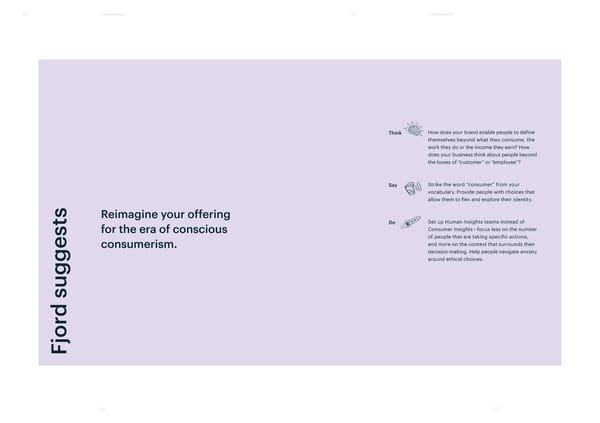
, ving on. While y e efficienc v tificial Intelligence (AI) is mo o Ar gely used to impr as lar ation will st, it w xt iter at fir t automation, its ne ting ough smar alue and suppor thr w v e about adding ne ystems be mor e can design s ’ll . If w e s skills with AI, w human ingenuity ’ ategies, ely blend people ss str ectiv that eff e busine vise disruptiv easing be able to de er people to cope with incr w empo orkplace and enhance the xity in the w comple . xperience human e
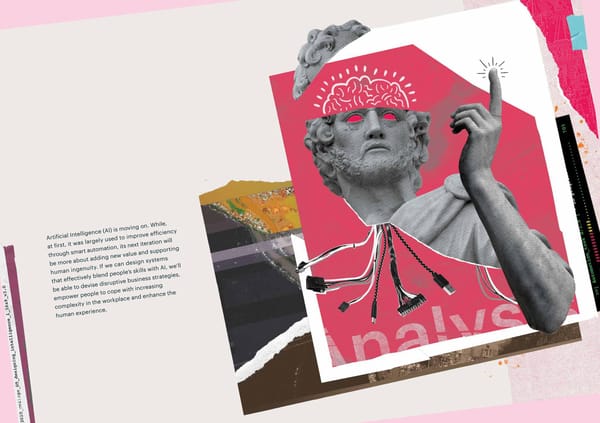

T5 Designing intelligence T5 Designing intelligence What’s going on? ASOS predicts customers’ lifetime value based on online shopping behavior, and 80 percent of US stock market activity is powered by algorithmic trading agents. No longer an emerging technology, AI is becoming woven “Since 2013, the tech industry has been re-making itself around intricately through our everyday lives. Organizations are now Machine Learning,” according to consultant and mobile analyst making impact by implementing AI in three ways: Benedict Evans. In Fjord Trends over the years since, we’ve predicted AI’s evolution: through Me, myself and AI in 2017 – First, the AI we’re aware of and increasingly take for granted about putting a human face and voice on AI and related – including apps that know how to categorize photos on our interactions at a customer service level – and in 2018’s phones, help us navigate the world, answer our questions or A machine’s search for meaning, in which we outlined the new control our devices via in-home agents. Usually the machine-to- dynamic of people and AI working together. human help can be divided into three clear categories: see, hear and recommend. For many businesses, early AI successes have revolved around automation, making the two seem synonymous – a Second, the AI we’re not always aware of – in smart services misunderstanding reinforced by a persistent narrative that like Stitch Fix, which offers personalized fashion curation by AI increasing AI reduces labor costs. Organizations are starting and algorithms in partnership with human stylists, and in the to recognize, however, that machines have limitations people Irish tax office’s sophisticated conversation agents that give don’t: AI can struggle to untangle unpredictable events, to people the answers they need 24/7. keep up with evolving systems, and to understand how such things affect people. Third is the AI we’re fully unaware of, but which helps to drive the products and services we use – unseen. Rolls-Royce uses it for Incidents of algorithmic bias, (where existing social injustices predictive maintenance, analyzing data from internet-connected get codified into AI advisors), contributes to racial discrimination sensors to spot signs of wear and tear in airplane engines, in healthcare and gender inequality in recruitment. Over- automation can also lead to complacency, as demonstrated by autonomous vehicle accidents where handover to human Start-up Atolla calibrates face serum to drivers failed. Even when organizations attempt to improve each customer’s exact skin characteristics. automation, we’ve seen examples of collateral damage – for instance, where efforts to stop internet bullying inadvertently resulted in LGBTQ advocates being demonetized or having content removed. As AI’s positive and negative effects unfold, we’re witnessing a growing divide in opinion. Businesses are accelerating their AI programs, with 80 percent reporting that it’s now in production within their organization in some form, yet customers and employees are becoming wary of its impact on their lives. 82 percent of Americans believe that AI and robots need to be managed carefully, and there’s evidence of rising resentment from workers whose labor is controlled by algorithms. To reconcile these differences, organizations must move beyond the automation mindset and start to see AI as a dynamic tool that employees can use to improve the business. Doing this requires better tools and more careful consideration of the economic and social effects of introducing the technology. Designing for AI means designing for human intelligence and optimizing the relationship between people and machines. 65 66
T5 Designing intelligence T5 Designing intelligence to help them understand and improve their operations. What’s next? However, to transform their insights into replicable actions, we must design trustworthy AI-driven tools and services that empower employees operating in these increasingly complex We’re breaking out of the categories of see, hear and and dynamic systems. recommend. Pioneering organizations have already evolved from automation to value creation, and are expecting In transport, Tokyo’s Railways Technical Research Institute (RTRI) radical changes in business models over the coming years. and the Swiss Federal Railways (SBB) are researching the use of neural networks and AI applications. Their aim is to combat Organizations will need new, systematic approaches for train delays and optimize scheduling in their complex networks unlocking the full potential of human collaboration with AI. We by helping dispatchers and controllers work with AI to make posed important questions in 2018 that remain unanswered: decisions and provide information to passengers. In healthcare, how will we interact with machines, how will we learn to work Moorfields Eye Hospital and DeepMind built an ocular with them, how will they learn from us, and how will we create diagnostic prototype where the analysis of retina scans showed two-way communication? specifically what the diagnosis was based on, enabling doctors to make informed decisions. In our work with The Dock, (Accenture’s flagship R&D and global innovation center in Dublin, Ireland), Fjord has been In information technology, virtual infrastructures pose an even investigating these questions and the role of design to improve greater challenge to operations. The intangible nature of data people’s partnership with AI. This work has identified three and IT systems allows for complex dependencies to evolve, so areas where such collaboration should lead to dramatic value application performance companies like Dynatrace use AI creation in the next few years: enhancing the human experience, to monitor cloud infrastructure, alert managers to issues and empowering workers to tackle increasing complexity, and even provide root cause analysis. envisioning new products and services. In business, Marc Benioff, CEO of Salesforce, uses his company’s Firstly, designed correctly, AI can be used to create experiences AI product, Einstein, in board meetings to enable the team that are not just personalized but help us extend our perceptual to dynamically explore data as they plan. “The truth is that capabilities. It can enhance our vision – it’s allowing biologists business has become too complex and is moving too rapidly to see inside living cells, and enabling us to map deforestation for boards and CEOs to make good decisions without intelligent and biomass reduction that the naked eye might otherwise systems,” according MIT Sloan researchers. miss. It can extend our understanding – Google Lens’s advanced image recognition has evolved from helping anyone to read While AI is helping us understand business, design is helping instantly in foreign languages to identifying plants. It can make us understand AI. A critical factor as, across industries, more us better learners – Iris by Pluralsight is a technical training advisor that uses natural language processing and Machine Learning (ML) to recommend content, updating question difficulty and skill ratings as it collects feedback. AI can make us more conscientious communicators – Instagram uses AI to address bullying by detecting potentially harmful content, then asking the writer if they really want to post it. AI can help us manage our money better, as automated debt manager Tally neatly demonstrates. The second area of value creation is that AI helps us with complexity. The combination of digital transformation Tokyo’s Railways Technical and globalization has expanded the speed, complexity and Research Institute is working to scale of business infrastructure. This has required most help dispatchers and controllers work with AI to make decisions large organizations to establish in-house data science teams that combat delays. 67 68
T5 Designing intelligence T5 Designing intelligence and more business decisions are being managed by algorithms. Philippe Starck and Kartell’s “A.I” chair is a physical representation Some organizations are already researching ways to tackle of what people and machines can bias issues. do when they work together. For example, Accenture’s algorithmic fairness tool uses ML to detect potentially biased training data and suggest ways to adjust for it. Independent research groups like Share Lab conduct data investigations into themes including internet privacy, transparency and the sustainability of online platforms to clarify the role of data in the digital economy. By designing interfaces that make the logic of AI visible and open to human direction, and by mapping out the relationships between systems, we can enhance people’s trust in them. Thirdly, and possibly where the value created will be the greatest, we can expect to see a rapid change of focus within AI development to more complex activities like simulation, decision support and especially innovation. Some organizations In health and life sciences, Nuritas uses AI to help discover new are already using AI to speed up the design and innovation bioactive ingredients – one of which speeds up post-training of new products, services, and even entire business models. recovery by reducing inflammation. Skincare start-up Atolla’s Skin Health System gives people testing kits that measure the Finch is a new architectural tool that automatically reflows exact characteristics of their skin then sends them face serum the fittings within rooms when dimensions of a building are calibrated to their individual needs. US-based Freenome adjusted, potentially allowing senior architects to set up is using AI to turn hidden genome patterns into tools for early design systems that can adapt to different contexts. Designer detection and better treatment of cancer. Philippe Starck has been collaborating with Kartell to create the first chair designed through human/AI collaboration. Many of these examples use parametric design – a process where people set the goals, constraints and processes for a MakerSights is a decision engine used by Levi’s, Madewell and specific problem, and AI accelerates the discovery of an Allbirds that determines which styles will be winners and optimal solution. However, parametric design relies heavily on losers, narrowing the gap between what brands think customers complete information – unlike humans, who can infer missing want and what they do want. Start-up, Klydo, applies AI to pieces of a puzzle they can’t yet see. Neuro-evolution is an help strategy teams identify, prioritize and gain approval for approach where researchers set the goals to be achieved and innovation opportunities. the AI must figure out how to achieve them. The ability to solve problems with incomplete information is a big step toward making AI applicable to real business challenges. AlphaStar, (AI developed by DeepMind that can beat professionals at complex video game StarCraft II), is a powerful example: despite starting with incomplete information, it explored the world to create a diversity of strategies for winning the game. AI and people view the world very differently, and if we harness AI for innovation, we could generate ideas we’d never dream of ourselves. Coupling this radical novelty with human social AlphaStar can take incomplete awareness has the potential to solve problems of a scale information and still devise and complexity as yet unimaginable. It’s not a race against strategies to beat professionals at complex video game, StarCraft II. machines, but with machines. 69 70
T5 Designing intelligence T5 Designing intelligence “The truth is that business has become too complex and is moving too rapidly for boards and CEOs to make good decisions without intelligent systems.” — MIT Sloan researchers Designing well for AI means designing for the human intelligence around it, to get the very best from the relationship between people and machines. 71 72
T5 Designing intelligence T5 Designing intelligence Think How can you make AI part of your strategic decision-making process rather than just automation of individual tasks? Where in your processes does human input add more value, and where is AI better suited for the job? What human qualities will you intentionally design into your AI colleague? How will you effectively manage the interface and handover between people and machine? s Reimagine how to design AI Say Talk about AI in simple terms according to what it can do – see, hear, recommend – rather than st for the human intelligence technical descriptions, like “computer vision”. around it to step to the next Do Trust AI data to help you in your decision- level of value creation. making and mock-up your AI first before heavily investing in it – barriers to entry for AI prototypes has dropped dramatically, thanks to online prototyping platforms. d sugge jor F 73 74

acturing tools in manuf established e ar ace is on to data models ed 3D and e sonal, and the r sonaliz al twins lik er per ’ll off Digit e getting per y r y’ st, the , the w t fir . No s. A y e and industr selv estations of our y’ll combine with other a , the eate virtual manif s. Soon after or all our dat cr tunitie tual home f ement, tainment oppor y’ll become a vir equir enter , the entually y). As a basic r v s. E e service ol (at least in theor w digital agentiv e contr or our ne v sign f s. ’ll ha e arn to de st winner er which w v s must le o vice eate them will be the bigge ands and public ser w to cr br w that learn ho e the f – doubles


T6 Digital doubles T6 Digital doubles We could soon see our online behaviors and data reflected in digital doubles that we control. What’s going on? The aggregation of some personal information centrally is not a new idea: Microsoft’s .NET My Services was an attempt in 2001 to allow access to contacts, calendar and email which never fully materialized due to privacy and anti-competitive concerns. Google’s suite of products based on Gmail is arguably an up-to-date realization of this. What’s coming next, however, goes way beyond a central access point for static data, because it unleashes the power of metaphor in our understanding of what’s possible, which in turn will inspire acceptance of innovative services. In essence a digital double of me is easy to understand. Now we need to make it useful, secure and easy to interact with. Right now, we think of a digital twin as a virtual model of a physical process, product or service. The pairing of virtual and physical allows data analysis and systems monitoring that make it possible to head off problems before they happen. As they can self-optimize over the course of a product or system’s life cycle, they’re increasingly being used by a diverse array of organizations and industries as virtual prototypes or test beds. For instance, UK start-up SenSat uses Artificial Intelligence to digitize real-world places for infrastructure projects, and recently attracted multimillion-dollar investment from Chinese multinational conglomerate Tencent. Gartner recently predicted that half of large industrial companies will use digital twin technologies by 2021, and according to Juniper Research, digital twin revenues will Eternime preserves people’s rise from US$9.8 billion this year to US$13 billion in 2023. memories for their loved ones Grand View Research predicts the global digital twin market to access long after they have passed away, allowing them will reach US$26.07 billion by 2025. to exist as an avatar forever. 77 78
T6 Digital doubles T6 Digital doubles Recently, digital twins have started to move beyond industry into new spheres. A range of other areas – such as financial Modeling agency The Diigitals only represents services, healthcare and the workplace – have started to synthetic models, including Shudu and Galaxia. recognize their potential. Social media is awash with digital selves, where it’s become the norm for people to interact via synthetic or filtered versions of themselves. It even hit the news when Chinese vlogger Qiao Biluo’s real appearance was exposed after a technical glitch disabled her beauty filter. Many teens and influencers have dual identities presented through fake social accounts called “finstas” – one to project a public profile for a wider audience, and another for close friends – to protect their privacy. In gaming, a growing number of female players use “voice skins” that distort their voices during chat room interactions with male gamers to avoid harassment. While these anonymity tools have the potential to make the internet feel safer, some suggest they could also make it riskier as they free people from accountability. For example, Snapchat’s hugely popular gender-swapping augmented reality lens – downloaded 7 million times in its first few weeks – has been used to catfish unsuspecting men on Tinder. In entertainment, Mackevision creates digital twins of products such as cars, planes or consumer goods, for visualization in content creation. In pornography, a sector that’s often an early adopter of new technology, Camasutra Industries has created high-resolution 3D scans of adult movie actors for use in VR porn. In fashion, there are digital supermodels such as Shudu and Galaxia from all-digital modeling agency The Diigitals, which only represents synthetic “humans”. Elsewhere, DNABlock is a start-up that creates 3D avatars of people from high-resolution 3D scans, allowing them to put their own avatar to work, licenced out by the agency. “Anything you can really think of that a human can do digitally, you can replace with an avatar,” says DNABlock co-founder Christine Marzano. “Anything you can really think of that a human can do digitally, you can replace with an avatar.” — Christine Marzano, co-founder of DNABlock 79 80
T6 Digital doubles T6 Digital doubles Digital twins are also being recognized as an invaluable tool for brands to surface relevant solutions when people are likely to be most receptive to offers based on their unique interests, driving the future of customer loyalty. Meanwhile, emotional chatbot service Replika creates a personal AI with whom a user can express and share life events. Eternime collects a deceased person’s online presence and makes a digital replica of them for their loved ones. Employers are collecting employee data to improve productivity and proactively monitor attrition. In its Decoding Organizational DNA report, Accenture Strategy suggests that implementing responsible data strategies can help build employee trust and help generate sustained revenue growth. At IBM, AI – which has replaced 30 percent of the company’s HR staff – can use their extensive workforce data to help employees identify new skills training, education, job promotions and raises, and The Living Heart Project is exploring what we could to predict with 95 percent accuracy which people are about achieve if medical devices could be designed to resign. and safely tested virtually before being tested in the real world. In our trends last year, we predicted Synthetic realities – AI-generated realities mixing real and virtual. As digital twins and synthetic realities further combine, we will see the emergence of the next generation, personal equivalent – digital doubles that combine your data, context and aggregated external information. 81 82
T6 Digital doubles T6 Digital doubles What’s next? AI is enhancing quality of life for people with degenerative conditions. When Dr. Peter Scott-Morgan was diagnosed with motor neuron disease, he decided to transform himself into a cyborg. Working with a team of doctors, technologists and In the near future, we can expect people to start designing and designers, he has become a living experiment in pushing the controlling their own ecosystems, ruled by algorithms they own limits of human interaction with AI. and that serve their best interests–not those of companies. “It’s going to be very personalized, very individualized, because what A different flavor of digital twin, a new breed of “agentive you want when you go on vacation might be very different from services” is now under development, in response to concerns what I want. Your personal digital twin will know that and work for about privacy and safety combined with the complexity of you and mine works for me,” says Forrester Vice President and the modern world. AI-driven Polisis reads and digests complex Principal Analyst on Customer Experience Rick Parrish. privacy policies so people don’t have to, and NDA Lynn is an AI lawyer that will review a non-disclosure agreement for its user. The ongoing absence of true data portability has been blamed Meanwhile, Awario tracks mentions of a particular brand. for maintaining monopolies and harming workers. In turn, this has perpetuated a situation in which people generate data they As everyday services like automated banking start to combine exchange for services with social media companies, search with digital twins’ data intelligence, it’s probable that people engines, online retailers, governments or banks. Digital doubles will increasingly want everything in one place and under their will re-write this model: by doing the work with companies control. Instead of struggling to understand our personal data and serving back to the user the best solutions for them, they stored in amorphous, abstract clouds, we could keep it in our will begin to become the gatekeepers of our digital lives. digital double – the perfect mental model for our data double – and nurture it to expand its capability, Tamagotchi-style. Ultimately, your digital double should act in your interest and on your behalf in many areas of your life. Imagine it booking Organizations will need to understand digital doubles from your vacations knowing not only your preferences, but also both a business and human perspective. Google learned this your calendar and budget (not now but in the future) – saving lesson through its ongoing development of Duplex – in effect, you money, effort and anxiety while adding enjoyment and a digital double by proxy – which initially proved a confusing experience. A digital double should flip spammy product push experience for people on the receiving end, some of whom and advertising on its head, shielding you from the avalanche mistook Duplex for a spam call. Following feedback, Google has of fragmented recommendations, instead guiding you in ways announced plans to position Duplex to help people book car that fit your lifestyle and preferences, while caring for your rentals and movie tickets. wallet and the planet. Of course, this scenario is still some way off, yet we see clear steps toward it. Companies must be careful when striving to understand how people relate to their digital doubles, and how their The Data Transfer Project is the first step toward housing all existence changes the way people see themselves. The way of a person’s data in one place. By facilitating a collaboration our digital doubles are visualized will be important. If we between major technology platforms, it’s building a common see a proliferation of digital doubles based on idealized framework that will enable people to move their data between or objectified representations of people, there’s obvious two platforms seamlessly, directly, and at their own initiation. potential for negative impact on our self-image, as we saw with the airbrushing controversy a few years ago. In life sciences, digital twins are in the research phase, but will eventually be used to project, predict or validate the outcomes The critical consideration for people will be: who do I trust to of medications, surgeries and lifestyle choices. The Living Heart host my digital double? A critical consideration for organizations Project aims to repurpose advanced simulation technology will be: how can we design trust and safety in to give people used by the automotive, aerospace, energy and tech industries the confidence to choose us as their host? It will be important to analyze patients’ health and plan therapies and surgeries to design any personal digital double experience to make it – University of Auckland has developed a virtual lung with engaging, transparent and seamless. Interface and interactions similar intentions. must match the mental model – and must be simple and clear. 83 84
T6 Digital doubles T6 Digital doubles “Companies must be careful when striving to understand how people relate to their digital doubles, and how their existence changes the way people see themselves.” — Fjord Trends 2020 Who do you trust to host your digital double? 85 86
T6 Digital doubles T6 Digital doubles Think What category of interactions could be opened up by digital doubles? Shape your strategy with digital doubles around three use cases: 1. Delegating tasks for you. 2. Masquerading your presence. 3. Modeling your behavior or future. Say Make it clear to people that they have control of their data – not you – and demonstrate that s Reimagine the your platform can be trusted to win customers st representation and employees. of people. Do Ensure data reliability, but make sure you’re not overly dependent on the data – always include the “lived reality”. Avoid falling into the gamification trap but do play and experiment, as this is a new realm with properties which are as yet undetermined. d sugge jor F 87 88
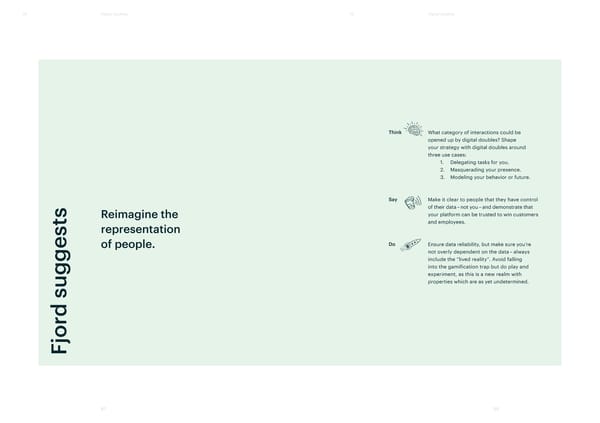
orking to define e w ganizations ar e w or w people ar xamine ho ear e ofit, and ho y buy ends this y Our tr wth that sit alongside pr y the items the o es simply b orms of gr eal that w f v ne e y r , the om defining themselv e om y fr a w ving fr ving a t of the same pictur mo . As par easibility is mo y do eel ork the , viability and f sign will f or the w ability ed de sir -center or v ocus of de s, user a s f ’ ate witch in f people ”. As this acceler e a s e w d “ ar w s emphasis will mak ” to ’ me sign “ easingly selfish and de incr . e or all lif of design f
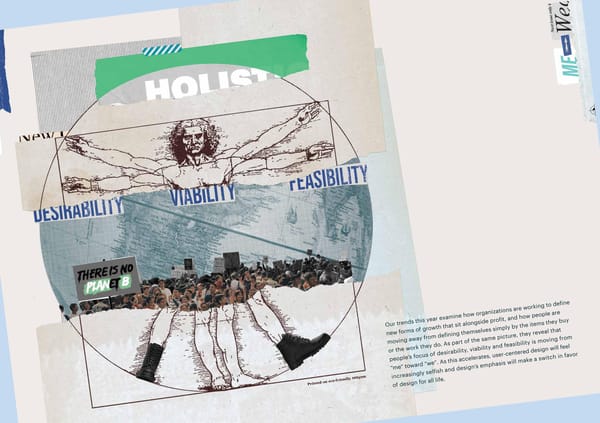

T7 Life-centered design T7 Life-centered design Design is perfectly positioned to introduce a systems mindset into any business, due What’s going on? to its multi-disciplinary, facilitatory role. We’re all adjusting our balance, so design will need to shift its emphasis in response. Life-centered design – inspired by writer John Thackara’s theory of designing for all life, not just human life – is the response to the trends we are highlighting this year, particularly Many faces of growth. As we witness a shift from “me” to “we” unfolding across the political and social spectrum, we can also see an evolution in design from user-centered to human-centered and now life- centered design. We’re starting to edge away from designing for one to designing for the collective – i.e. the entire planet. “The perfect overlap between desirability, The values contained in the traditional Venn diagram of feasibility and viability is a sustainable desirability, feasibility and viability are fundamentally changing – as are our design responses to them. and/or a desirable product or service that Until very recently, desirability has been all about what’s in it — Fjord Trends 2020 also makes business sense.” for the user or customer. Increasingly, it’s becoming about what’s in it for the customer and their collective cause across the political spectrum – whether that means sustainable living or taking sides in a trade war. US skincare and cosmetic 91 92
T7 Life-centered design T7 Life-centered design business Beautycounter’s The Never List of toxic ingredients it pledges to never use in its products is one example of how desirability is being redefined. City First Bank of DC’s commitment to prioritizing 80 percent of its loans to underserved communities is another. French food giant Danone established Danone Manifesto Ventures to partner with a community of disruptive entrepreneurs focused on creating a healthy and sustainable future of food. Meat is a well-publicized example. Once, people would enjoy the luxury of a 28-day dry-aged burger, and appreciate the time and effort it took to achieve that quality. Now, the enjoyment of eating an Impossible Burger comes from the knowledge that we’re eating something that’s better for the planet. This is a redefinition of desirability made possible by new material and food technologies and a Silicon Valley-style business model comprising venture capital funding, rapid experimentation and innovation, and bringing a clear story to market. The intersection between desirability, feasibility and Feasibility was once governed by material or digital production viability is evolving–we’re all becoming less and consumption. Increasingly, it’s becoming governed by self-centered and more life-centered. life cycles of environmental and societal impact. Digital has radically changed what’s possible, but new materials and changing societal behaviors are swiftly catching up in the physical world. For example, in India, Saathi developed the world’s first 100 percent biodegradable sanitary pad from banana fiber – the company claims to eliminate 60kg of pad waste per woman in her lifetime. Fairphone is a smartphone “for everyone who cares about how their products are made” because “how it’s made matters”. It improves the conditions of the people who make it and uses materials that are better for the planet. Unilever’s trial of refillable packs, based on a model in which ownership of the packaging passes from customer to manufacturer, is enabled by the recently launched global e-commerce retail platform LOOP. Brands can exploit a considerable opportunity by providing a guilt-free consumer experience – this is part of the explanation for the phenomenal rise of re-sale, an industry growing 21 times faster than conventional retail. Stuffstr is a start-up that enables customers to sell back the apparel they no longer use to their favorite retailer, making re-commerce a part of every retail transaction. Nudie Jeans offers free repairs for life, while a cult Danish label recently launched a rental proposition: GANNI Repeat. 93 94
T7 Life-centered design T7 Life-centered design These examples were only made viable because they offered short-term return on investment and shareholder value. Increasingly, viability is being shaped by a project’s contribution to a broader purpose in the world. Outdoor products brand and certified B Corporation Cotopaxi was founded on the idea that the interest of profit and people could not only co-exist but could be mutually beneficial. From its giving model to its company culture and sustainable product design, it sees its business as a vehicle to make a positive impact. In another example, asset management firm BlackRock has launched two funds for environmental, societal and governance (ESG) issues. Soon, the only viable business model will be one that takes ESG concerns into account. Design that brings customers into a collective cause is one example of life-centered design. In Denmark, designers Mater work at the forefront of sustainable materials, incorporating recycled plastic and aluminum into a wide range of home furnishings and, by so doing, introducing more people to sustainability while embedding transparency into the design journey. The perfect overlap between desirability, feasibility and viability is a sustainable and/or a desirable product or service that also makes business sense. For instance, iconic shoe brand Dr. Martens boosted profits by 70 percent when it introduced a vegan range of footwear made from synthetic material. Elsewhere, global architecture firm Snøhetta has developed Powerhouse, a super-efficient building that generates solar energy for the neighboring community, producing twice the energy it consumes. Dr. Martens launched a range of vegan footwear, meeting people’s desire for products with ethical credentials. 95 96
T7 Life-centered design T7 Life-centered design As John Thackara has observed, because everything affects everything else in one way or another, organizations will increasingly need a systems mindset when dealing with complex What’s next? problem-solving. A systems mindset combines purpose with people, with life at its heart, and comes from many years of practice, craft and habit. Thanks to the multi-disciplinary, The world’s northernmost facilitatory role that design plays, designers are well-placed to energy-positive building, introduce this mindset to any business. In today’s fast-changing Powerhouse Brattørkaia landscape, designers must change, too. aims to produce more energy than it consumes over its lifespan, Typically, design has always keenly felt the impact of including construction and demolition. technological change, most obviously industrial (designing the tools to make objects indirectly), and digital (using code to design experiences mediated by a screen). These changes introduced layers of abstraction and experience. Previously, when designing for digital, designers needed to understand the devices their designs would be consumed on and the contexts in which they would be experienced. Next, they must broaden their understanding to look at entire systems as they increasingly design for all life. “Design is a connecting tool between people, economics and the environment – and out of this communion, understanding and respect for new ideas and products with integrity can come,” according to Dr. Carmen Hijosa, creator of sustainable textile Piñatex and CEO of the company that makes it, Ananas Anam. For years, the application of user-centered and human-centered design advocated by so many has often separated people Businesses struggle to keep up with the rapid shifts in customer from ecosystems. Now, designers must start to address people values and, as they continue to evolve at a pace, the pressure as part of an ecosystem rather than at the center of everything. is on organizations to respond effectively. Those producing This means designing for two sets of values: personal and physical goods will have to change often complex supply chain collective. Designers and clients must both face this complexity and manufacturing processes in time to meet customers’ head-on and unite the best of systems thinking and practice, demand for purposeful products and services that make a together with design practice. As we design both for this and positive impact. Those in digital must replace their business for the migration from current systems to a new one, we’ll model of constant engagement and self-service with alternatives use transition design frameworks more and more. that reinstate the interpersonal connections, attention and time that people want. The trade-offs between our desires and convenience – between health, joy and ease – will need to be managed carefully. There’s opportunity in combining digital and physical re-design. Winning brands will increasingly be those that help people In the UK, IKEA’s kitchen of the future partnership with the navigate their ethical anxieties about consumption by delivering AI-system Winnow – which automates food waste capture and alternative engaging experiences. Those brands that fail to provides richer insight to help kitchen teams reduce waste turn words to action, demonstrate evidence of their purpose and increase efficiency – saved it 50 percent of its in-store and increase their ESG metrics may struggle. In short, design food waste. must now extend beyond its own ecosystem. 97 98
T7 Life-centered design T7 Life-centered design “Design is a connecting tool between people, economics and the environment – and out of this communion, understanding and respect for new ideas and products with integrity can come.” — Dr. Carmen Hijosa, CEO of Ananas Anam People’s attitude to their planet is evolving, and businesses must prioritize environmental, societal and governance concerns. 99 100
T7 Life-centered design T7 Life-centered design Think Redefine desirability, feasibility, viability in your work. How can your offering become regenerative by design, including deleted items that disappear from view? How can you use design as a central tool for creating alignment around change, and the purpose of innovation? Say State that you consider natural, political and societal ecosystems as equals – practice “do s Reimagine the role no harm” in all areas, rather than paying lip service. Demonstrate that life-centered design st of design in 2020. is your new norm, and not just a project. Do Update your design skillset with systems thinking. Collaborate with other disciplines, such as scientists, technologists and futurists, and actively design in systems that encourage people to reduce their use of resources. d sugge jor F 101 102
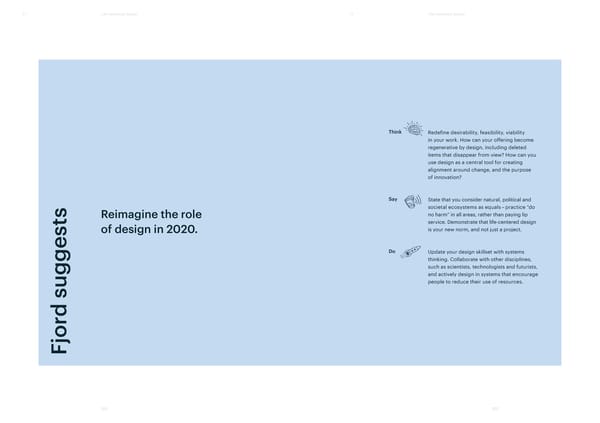
Trends 2020 Realigning the fundamentals Trends 2020 Realigning the fundamentals References Many faces of growth Emma Charlton, World Economic Money changers Victor Cortes, Conxto.com, Steve Lepitak, The Drum, “Disney’s Forum, “New Zealand has unveiled “MercadoPago and Xapo, two Dumbo and Accenture Interactive Ray Dalio, LinkedIn, “Why and how its first ‘well-being’ budget”, May Harrison Jacobs, Business Insider, Latin American companies joining collaborate on the poster of the capitalism needs to be reformed 30, 2019 “One photo shows that China Facebook’s Libra Association”, future,” March 10, 2019 (Parts 1 & 2)”, April 5, 2019 is already in a cashless future”, June 19, 2019 Fjord, Fjord Trends 2018 May 29, 2018 Gulfnews, “India planning to set Alan Murray, Fortune, “America’s The World Bank, “The Global up one of the world’s largest CEOs seek a new purpose for the Denis Machuel, LinkedIn, “Taking CBS News, “Sweden is going Findex Database” facial recognition systems”, corporation”, August 19, 2019 action against food waste: an cashless”, May 5, 2019 September 20, 2019 urgent priority to limit climate Will Ruddick, The Green Political Sean Farrell, The Guardian, change”, October 16, 2019 Accenture, “Payments Pulse Foundation, “How the Bangla-Pesa Bloomberg, Gulf News, “India “‘Damaged ideology’: business Survey: Two ways to win tapped the value of an informal planning to set up one of the must reinvent capitalism – ex- Mariana Mazzucato, World payments”, September 9, 2019 community”, January 25, 2016 world’s largest facial recognition Unilever boss”, October 29, 2019 Economic Forum, “How to creates systems”, September 20, 2019 a more purposeful capitalism”, Tommy Wilks, Reuters, “Start-ups Ian Withers, Reuters, “Britain’s RBS Marc Benioff, The New York January 15, 2019 to grab $280 billion in banking launches digital bank Bó to take Kyle Wiggers, VentureBeat, “AI Times, Marc Benioff: We need a payments revenues by 2025, on start-ups”, November 27, 2019 Weekly: in China, you can no new capitalism, October 14, 2019 George Monbiot, The Guardian, study says”, September 6, 2019 longer buy a smartphone without “Finally, a breakthrough Quentin Fottrell, MarketWatch.com, a face scan”, October 11, 2019 Financial Times, “FT sets the alternative to growth economics Barry Eichengreen, The Guardian, “Silicon Valley’s final frontier for agenda with new brand platform”, – the doughnut”, April 12, 2017 “Libra: will Facebook’s new payments: ‘The neoliberal David Hambling, MIT Technology September 16, 2019 currency be stopped in its takeover of the human body’”, Review, “The Pentagon has a laser Robert Eccles, Harvard Business tracks?”, October 14, 2019 October 23, 2019 that can identify people from a Ellen MacArthur Foundation, Review, “Why it’s time to finally distance – by their heartbeat”, “BlackRock becomes Ellen worry about ESG”, May 21, 2019 Damon Beres, Medium.com, “The Accenture, “Driving the future of June 27, 2019 MacArthur Foundation global Apple Card explains everything payments 10 mega-trends” partner”, October 8, 2019 Mattha Busby, The Guardian, you need to know about Apple Kate Conger, Richard Fausset, “Capitalism is part of solution today”, September 12, 2019 Images Serge F Kovaleski, New York Ahiza Garcia, CNN Business, to climate change, says Mark Times, “San Francisco bans “Amazon workers walk out to Carney”, July 31, 2019 Jack Derwin, Business Insider, Apple Card. facial recognition technology”, protect climate change inaction”, “Australia just got a new digital Credit: Mark Solarski/Unsplash May 14, 2019 September 20, 2019 Accenture, “Business contribution bank called 86 400 and its chair to the 2030 agenda for sustainable has a history of taking on the big Monese. Credit: Monese Kaiyu Yang Klint Qinami, Li Fei-Fei, Brian Kahn, Gizmodo, “It’s kids vs. development not on track, end of town”, July 18, 2019 Jia Deng, Olga Russakovsky, the world in a landmark climate United Nations Global Compact Bó card. Credit: Bó Image-net, “Towards fairer complaint”, September 23, 2019 and Accenture study finds”, Monese, About datasets: filtering and balancing September 24, 2019 M-pesa agent in Kibera, the distribution of the people Esha Dey, Drew Singer, Ryan Emma Lunn, The Guardian, Nairobi, Kenya. subtree in the ImageNet Vlastelica, Kristine Owram and Business Roundtable, “Business “Klarna: buy now, pay later Credit: Fiona Graham/WorldRemit hierarchy”, September 17, 2019 Mathieu Benhamou, Bloomberg, Roundtable redefines the purpose system that is seducing “Unprofitable companies are of a corporation to promote millennials”, November 17, 2018 ATM. Naomi Rea, ArtNet, “How ImageNet raising the most IPO cash since ‘an economy that serves all Credit: Mirza Babic/Unsplash Roulette, an art project that the dot-com era”, September 25, Americans’”, August 19, 2019 Jamie Redman, Bitcoin.com, went viral by exposing facial 2019 “Africa’s interest in bitcoin remains recognition’s biases, is changing Images high as 15 states plans to adopt people’s minds about AI”, James D Walsh, New York Magazine, the Eco currency”, July 2, 2019 Walking barcodes September 23, 2019 “At what point does malfeasance Greta Thunberg poster. become fraud? NYU biz-school Credit: Radu Stanescu/Unsplash Anthony Cutherbertson, Nicole Lindsey, CPO Magazine, Professor Scott Galloway on The Independent, “China bans Hal Hodson, The Economist – The “Amazon’s new smart products WeWork”, October 1, 2019 Capitalism. Time for a reset. anti-blockchain sentiment as it World in 2019, “The face becomes raise all kinds of Alexa privacy Credit: The Financial Times prepares for launch of state a barcode” concerns”, October 9, 2019 Sandra Laville, The Guardian, cryptocurrency”, October 30, The Guardian, “Smile to Pay: “Swedish newspaper stops taking Cyclist in Auckland, New Zealand. 2019 Chris Baynes, The Independent, adverts from fossil fuel firms”, Credit: Dan Freeman/Unsplash Chinese shoppers to turn to facial “Chinese schools scanning September 26, 2019 Gian Volpicelli, Wired, “What is payment technology”, September children’s brains to see if they are WeWork logo on wall. Libra? Facebook’s cryptocurrency 4, 2019 concentrating”, January 15, 2019 Abha Bhattari, The Washington Post, Credit: Ariann Laurin/Unsplash explained”, August 14, 2019 Mark Manning, Mendix, “Zurich entureBeat, “The status quo is unacceptable: Khari Johnson, V Walmart will stop selling some Bosco verticale, Green in the city, Richard Partrington, The FaceQuote goes from ide to app “Facebook alters video to make ammunition and exit the handgun Milan, Italy. Guardian, “France to block in week”, June 13, 2019 people invisible to facial market”, September 4, 2019 Credit: Chris Barbalis/Unsplash Facebook’s Libra currency in recognition”, October 25, 2019 Europe”, September 12, 2019 103 104
Trends 2020 Realigning the fundamentals Trends 2020 Realigning the fundamentals Bernard Marr, Forbes, “The amazing Woman using Meitu’s makeup+. Julia LaRoche, Yahoo, “Starbucks Silvia Amaro, CNBC, “Sell-offs Gregg Schoenberg, TechCrunch, Train station employee, Tokyo ways Babylon health is using AIU Credit: Meitu (video) to offer mental health service could be down to machines that “Tally’s Jason Brown on fintech’s Station, Chiyoda-ku, Japan. to make healthcare universally as new employee benefit”, control 80% of the US stock first debt roboadvisor and an Credit: Victoriano Izquierdo/ accessible”, August 6, 2019 Portrait of woman with digital September 5, 2019 market, fund manager says”, automated financial future”, Unsplash typography across face. December 5, 2018 June19, 2019 Salvador Rodriguez, CNBC, Credit: Donny Jiang/Unsplash United Nations, “World Population AlphaStar and StarCraft II “Facebook agrees to acquire Prospects 2019” Ben Evans, Benedict Evans, Gayang Ho, Global Railway Review, gameplay. brain-computing start-up “Machine learning deployment”, “Artificial Intelligence in rail: hype Credit: DeepMind and Blizzard CRTL-labs”, September 23, 2019 European Commission, “2018 October 4, 2019 or reality?”, May 15, 2019 Liquid people Ageing Report: Policy challenges Woman with hologram Intel, “How 5G will transform for ageing societies” Wired, “A health care algorithm Charlotte Jee, MIT Technology data on wrist. the business of media and Everlane, Black Friday Fund, 2019 offered less care to black Review, “DeepMind has Credit: Justin Peralta/Unsplash entertainment”, October 2018 United States Census Bureau, patients”, October 24, 2019 made a prototype product that Beth Desmond, New Statesman, “Older people projected to can diagnose eye diseases”, A.I. chair. Credit: Kartell 5G World Pro, “SK Telecom to open “How gender fluidity went outnumber children for the first Jeffrey Dastin, Reuters, “Amazon April 1, 2019 5G hospital in 2020”, May 6, 2019 mainstream”, June 12, 2019 time in US history”, March 13, 2018 scraps secret AI recruiting tool that showed bias against women”, Alex Hickey, CIO Dive, “AI sits in Wired, “How 5G will supercharge Eliana Dockterman, Time, “A doll Kerry Hannon, The New York October 10, 2018 on Salesforce’s board meetings Digital doubles business to work in real time”, for everyone: meet Mattel’s new Times, “My work life is over. What’s and has something to say”, August 8, 2019 gender-neutral doll”, September next?”, September 12, 2019 Ron Schmelzer, Forbes, “What January 26, 2018 Brian Buntz, IoTWorldToday, “Of 25, 2019 happens when self-driving cars custom shoes and bottles: digital Sidney Fussell, The Atlantic, Images kill people?”, September 26, 2019 Barry Libert, Megan Beck, and twin technology grows up”, May 1, “YouTube videos are a gold Peter Johnson, The HR Director, Mark Bonchek, MIT Sloan 2018 mine for health researchers”, “Rise of the freelancer – self- Impossible bao. Aja Romano, Vox, “A group of Management Review, “AI in the September 9, 2019 employed spikes as people seek Credit: Impossible Foods YouTubers is trying to prove the boardroom: the next realm of Paul Sawers, VentureBeat, flex”, June 11, 2019 site systematically demonetizes corporate governance”, October “Tencent leads $10 million Pyments.com, “Alipay to add Snowy view from inside queer content”, October 10, 2019 19, 2017 investments in SenSat to create beauty filters to facial recognition Katharine Schwab, Fast Company, train carriage. real-time simulated realities”, kiosks in China”, July 3, 2019 “These plant-based food Credit: Mike Petrucci/Unsplash Louis Columbus, Forbes, “80% Finch 3D, Design tool for October 1, 2019 companies are re-branding to of enterprises are investing in AI architechts Seth Miller, Paxex.aero, target meat eaters – and it’s Mattel Creatable World dolls. today”, October 16, 2017 CIO&Leader, “Digital twin revenues “Biometrics expand in Asia, working”, July 25, 2019 Credit: Mattel Sebastian Jordahn, Dezeen, to rise by 2023, boosted by AI Europe and the Middle East”, Governanceai, “Artificial “Philippe Starck, Kartell and and ML innovation”, April 12, 2019 October 9, 2019 Adele Peters, Fast Company, Plastic waste, MAAS, intelligence: American attitudes Autodesk unveil ‘world’s first “Think fake burgers are just for Lisbon, Portugal. and trends”, January, 2019 production chair designed with Grand View Research, “Digital Leon Kelion, bbc.co.uk, “Gatwick vegetarians? 95% of Impossible Credit: Martijn Baudoin/Unsplash artificial intelligence’”, April 11, twin market size worth $26.07 airports commit to facial Foods customers are meat eater” Mareike Möhlmann and Ola 2019 billion by 2025”, December 2018 recognition tech at boarding”, September 18, 2019 Old woman laughing. Henfridsson, Harvard Business September 17, 2019 Credit: Huyen Nguyen/Unsplash Review, “What people hate about MakerInsights, Product decision Druhti Shah, Kerry Allen, BBC, Robert Booth, The Guardian, being managed by algorithms, engine for retail “Chinese vlogger who used filter Jenni Reid, Business Traveller, “Vegan food becomes UK’s according to a study of Uber to look younger caught in “Facial recognition kiosk gives fastest-growing take-away”, drivers”, August 30, 2019 Klydo.ai, 2019 live-stream glitch”, July 30, 2019 flight updates at Chinese August 28, 2019 Designing intelligence airports”, March 27, 2019 John Pavlus, Quanta Magazine, Nuritas.com, 2019 Ephrat Livni, qz.com, “Voice Richard Moller, YouGov, “Is Stitch Fix, Algorithms tour, 2019 “His Artificial Intelligence sees skins will make the internet a Madeleine Hillyer, World Economic inside living cells”, July 24, 2019 Dezeen, flexitarianism the diet of the Rima Sabina Aouf, freer – but more dangerous – Forum, “World Economic Forum future?”, March 26, 2019 Ciara O’Brien, The Irish Times, “Start-up Atolla harnesses AI to place”, May 21, 2019 consortium launches paperless “Revenue turns into a digital bot Connor Upton, Design Voices, make personalised skincare Canada-Netherlands travel pilot”, Douglas Broom, World Economic to answer your tax queries”, “Computers have eyes, but products”, September 3, 2019 Paige Leskin, Business Insider, June 26, 2019 Forum, “Sweden has invented a September 6, 2018 where’s the vision?”, April 16, 2018 “People are loving the new word to encourage people not to Matthew Hutson, Quanta gender-swapping Snapchat filter, Images fly. And it’s working”, June 5, 2019 Mark Samuels, ZDNet, “Successful Devon Delfino, Business Insider, Magazine, “Computers evolve and it’s not being used to catfish IoT deployment: the Rolls-Royce “How to use Google Lens to identify a new path toward human unsuspecting men on Tinder”, People walking on crossing. BBC, “Flight shame could approach”, May 15, 2018 objects and learn more information intelligence”, November 6, 2019 May 15, 2019 Credit: Ryoji Iwata/Unsplash halve growth in air traffic”, using your camera and Google October 2, 2019 Karen Nyawera, HBS Digital Assistant”, September 10, 2019 Daniel Shapiro, Forbes, Mackevision, “Automobil Industrie Amazon Echo Loop. Initiative, “Fashion forward – using “Can artificial intelligence – Partners of Digitization: Credit: Amazon.com, Inc. Miya Tokumitsu, Jacobin deep learning at ASOS to predict Pluralsight, Iris generate corporate strategy?”, Mackevision on Digital Twins”, Magazine, “In the name of love”, customer lifetime value in online August 19, 2019 April 11, 2019 Customer uses facial recognition December 1, 2014 fashion retail”, January 12, 2019 Miranda Bryant, The Guardian, as identification at security “Instagram’s anti-bullying AI asks Images Camasutraindustries.com, 2019 checkpoint. Credit: John Paul Van Derek Thompson, The Atlantic, users: ‘Are you sure you want to Wert/Delta News Hub “Workism is making Americans post this?’”, July 9, 2019 Skin Health System kit. miserable”, February 24, 2019 Credit: Atolla 105 106
Trends 2020 Realigning the fundamentals Trends 2020 Realigning the fundamentals Justin Kirkland, Esquire, “This Hannah Martin, Stuff, “Auckland Laura James, Forbes, “Impossible Images porn company wants to use researchers build virtual lungs Burger to finally make its grocery Virtual Reality to keep you alive to better diagnose and treat store debut – but will excitement Designers in Fjord Tokyo studio. forever”, May 31, 2018 patients”, July 8, 2019 match its Burger King launch?”, Credit: Fjord Tokyo September 19, 2019 Thediigitals.com, 2019 The Times, “I’m dealing Home office. with motor neurone disease Solve, Saathi solution Credit: Gabriel Beaudry BBC, “Avatars, are we ready by becoming a cyborg”, for our digital twins?”, October August 3, 2019 Fairphone.com, 2019 Person walking on wooden edge. 28, 2019 Credit: Kilian Photo/Unsplash Andy Greenberg, Wired, “An AI David Blanchard, Unilever, “We’re Ed Hackworth, Computer that reads privacy policies so you introducing reusable, refillable Snøhetta Powerhouse Business Review, “Why the digital don’t have to”, September 2, 2018 packaging to help cut waste”, Brattørkaia, Trondheim, Norway. twin is the key to customer January 24, 2019 Credit: synlig.no loyalty”, May 14, 2019 NDA Lynn.com, 2019 Renae Reints, Fortune, “The resale Person hugging tree. Arielle Pardes, Wired, Awario, Instagram market is taking over fast fashion, Credit: Will Cornfield/Unsplash “The emotional chatbots are report says”, March 19, 2019 here to probe our feelings”, Natt Garun, The Verge, “One year January 31, 2018 later, restaurants are still confused Stuffstr.com, 2019 by Google Duplex”, May 9, 2019 Ameila Tait, The Guardian, “What Nudiejeans.com, 2019 happens to our online identities Natt Garun, The Verge, “Google is when we die?” June 2, 2019 bringing Duplex to the web to Susan Devaney, Vogue, “You can help book car rentals and movie now rent GANNI’S cult Scandi Accenture, “More responsible tickets”, May 7, 2019 designs”, September 21, 2019 use of workforce data required to strengthen employee trust Images Daniela Esnerova, Money and unlock growth, according Marketing, “BlackRock launches to Accenture report”, January Woman looking up into mirror. ESG tax-transparent funds”, 22, 2019 Credit: Vale Zmeykov/Unsplash July 17, 2019 Eric Rosenbaum, CNBC, “IBM AI Credit: Eternime Mater Design, 2019 can predict with 95% accuracy which workers are about to quit Galaxia. Credit: The Diigitals Roddy Clarke, Forbes, their jobs”, April 3, 2019 “Transparency is what conscious The Living Heart Project. consumers urgently need Lisa Lacy, AdWeek, “3 ways CX Credit: Dassault Systèmes from design brands today”, is about to drastically change”, April 27, 2019 September 4, 2019 Two people wearing pink wigs. Credit: Chan/Unsplash Sarah Young, The Independent, Will Grimond, The RSA, “Dr Martens’ profits soar by 70 “Why can’t I move my data?”, percent over success of new September 11, 2019 vegan range”, August 13, 2019 Life-centered design Disclaimer third parties Don Tapscott, qz.com, “We’re Designboom “Snøhetta living in an era of digital Gerry Scullion, This is HCD, completes the world’s feudalism. Here’s how to take “John Thackara ‘Designing for northernmost energy-positive This document makes descriptive reference to trademarks that your data and identity back”, all of life, not just human life’”, building in Norway” may be owned by others. The use of such trademarks herein is September 11, 2019 October 23, 2018 Winnow Solutions, “IKEA and not an assertion of ownership of such trademarks by Accenture Fatemeh Khatibloo with Mary Beautycounter.com, 2019 Winnow are building the kitchen and is not intended to represent or imply the existence of an Pilecki, Shar VanBoskirk, Joe of the future” association between Accenture and the lawful owners of such Stanhope, Matthew Flug, Christine Cfenterprises.org, 2019 Turley, Forrester, “The algorithm Leyla Acaroglu, Medium, “Tools trademarks. This document is produced by professionals at of you: meet your personal digital Dominique Vidalon, Reuters, for systems thinkers: the 6 Accenture as general guidance. It is not intended to provide twin”, September 10, 2018 “French group Danone’s venture fundamental concepts of systems specific advice on your circumstances. If you require advice capital fund eyes 20-25 year deals thinking”, September 7, 2017 Datatransferproject.dev, 2019 by 2020”, June 22, 2018 or further details on any matters referred to, please contact Welum, “The Textile of the Future: your Accenture representative. 3ds.com, “The Living Heart Pinatex” Project” Copyright ©2019 Accenture. All rights reserved. Accenture and its logo are trademarks of Accenture. 107 108
Fjord, part of Accenture Interactive, is a design and innovation consultancy that reimagines people’s relationships with the digital and physical world around them. We use the power of design to create services people love. By combining a human-centered approach with robust methodology, we work with some of the world’s leading businesses to make complex systems simple and elegant. Founded in 2001, Fjord has a diverse team of 1,200 design and innovation experts in 33 studios, including Atlanta, Auckland, Austin, Barcelona, Berlin, Bogotá, Buenos Aires, Canberra, Chicago, Copenhagen, Dubai, Dublin, Helsinki, Johannesburg, Lima, London, Los Angeles, Madrid, Melbourne, Mexico City, Milan, New York, Paris, San Francisco, São Paulo, Seattle, Singapore, Stockholm, Sydney, Tokyo, Toronto, Washington, D.C. and Zurich. To learn more, follow us @fjord and visit www.fjordnet.com. Accenture Interactive helps the world’s leading brands transform their customer experiences across the entire customer journey. Through our connected offerings in design, marketing, content and commerce, we create new ways to win in today’s experience-led economy. Accenture Interactive is ranked the world’s largest digital agency in the latest Ad Age Agency Report for the fourth year in a row, and was named a 2019 Most Innovative Company in Advertising by Fast Company. To learn more, follow us @AccentureACTIVE and visit www.accentureinteractive.com. Accenture is a leading global professional services company, providing a broad range of services and solutions in strategy, consulting, digital, technology and operations. Combining unmatched experience and specialized skills across more than 40 industries and all business functions — underpinned by the world’s largest delivery network — Accenture works at the intersection of business and technology to help clients improve their performance and create sustainable value for their stakeholders. With 492,000 people serving clients in more than 120 countries, Accenture drives innovation to improve the way the world works and lives. Visit us at www.accenture.com. trends.fjordnet.com

